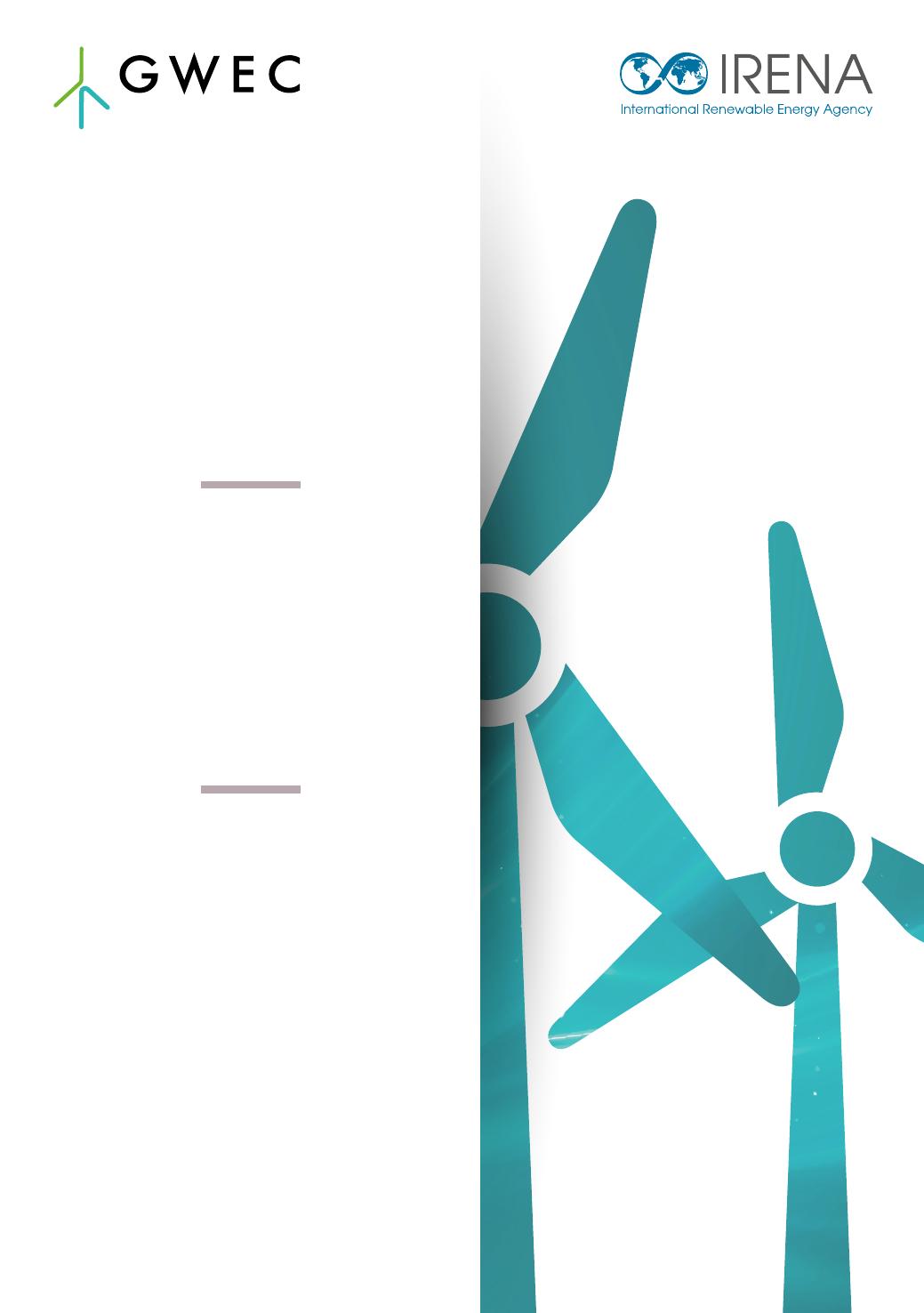GLOBALWINDENERGYCOUNCILENABLINGFRAMEWORKSFOROFFSHOREWINDSCALEUPINNOVATIONSINPERMITTINGAbrieffromtheIRENACollaborativeFrameworkonOceanEnergyandOffshoreRenewables©IRENA2023Unlessotherwisestated,materialinthispublicationmaybefreelyused,shared,copied,reproduced,printedand/orstored,providedthatappropriateacknowledgementisgivenofIRENAasthesourceandcopyrightholder.Materialinthispublicationthatisattributedtothirdpartiesmaybesubjecttoseparatetermsofuseandrestrictions,andappropriatepermissionsfromthesethirdpartiesmayneedtobesecuredbeforeanyuseofsuchmaterial.ISBN:978-92-9260-549-0Citation:�IRENAandGWEC(2023),Enablingframeworksforofshorewindscaleup:Innovationsinpermitting,InternationalRenewableEnergyAgency,AbuDhabi.AboutIRENATheInternationalRenewableEnergyAgency(IRENA)servesastheprincipalplatformforinternationalco-operation;acentreofexcellence;arepositoryofpolicy,technology,resourceandfnancialknowledge;andadriverofactiononthegroundtoadvancethetransformationoftheglobalenergysystem.Aglobalintergovernmentalorganisationestablishedin2011,IRENApromotesthewidespreadadoptionandsustainableuseofallformsofrenewableenergy,includingbioenergyandgeothermal,hydropower,ocean,solarandwindenergy,inthepursuitofsustainabledevelopment,energyaccess,energysecurity,andlow-carboneconomicgrowthandprosperity.www.irena.orgAboutGWECGWECisamember-basedorganisationthatrepresentstheentirewindenergysector.ThemembersofGWECrepresentover1500companies,organisationsandinstitutionsinmorethan80countries,includingmanufacturers,developers,componentsuppliers,researchinstitutes,nationalwindandrenewablesassociations,electricityproviders,financeandinsurancecompanies.GWECworksatthehighestinternationalpoliticalleveltocreateabetterpolicyenvironmentforwindpower.GWECanditsmembersareactiveallovertheworld,educatinglocalandnationalgovernmentsandinternationalagenciesaboutthebeneftsofwindpower.AcknowledgementsThisbriefwasauthoredbyJaidevDhavle(IRENA)andThoaNguyen(GWEC)undertheguidanceofFranciscoBoshell(IRENA),RebeccaWilliams(GWEC)andRolandRoesch(Director,IRENAInnovationandTechnologyCentre).ItalsobeneftedfromcontributionsbyJefreyTchouambe(ex-IRENA).Thisbriefhasbenefttedfrom,andincorporatestheinputsof,theIRENACollaborativeFrameworkonOceanEnergyandOfshoreRenewables.IRENAisgratefulforthegeneroussupportprovidedbytheEuropeanCommissionforthispublication.DisclaimerThispublicationandthematerialhereinareprovided“asis”.AllreasonableprecautionshavebeentakenbyIRENAtoverifythereliabilityofthematerialinthispublication.However,neitherIRENAnoranyofitsofcials,agents,dataorotherthird-partycontentprovidersprovidesawarrantyofanykind,eitherexpressedorimplied,andtheyacceptnoresponsibilityorliabilityforanyconsequenceofuseofthepublicationormaterialherein.TheinformationcontainedhereindoesnotnecessarilyrepresenttheviewsofallMembersofIRENA.ThementionofspecifccompaniesorcertainprojectsorproductsdoesnotimplythattheyareendorsedorrecommendedbyIRENAinpreferencetoothersofasimilarnaturethatarenotmentioned.ThedesignationsemployedandthepresentationofmaterialhereindonotimplytheexpressionofanyopiniononthepartofIRENAconcerningthelegalstatusofanyregion,country,territory,cityorareaorofitsauthorities,orconcerningthedelimitationoffrontiersorboundaries.CONTENTSABBREVIATIONS.6EXECUTIVESUMMARY.801INTRODUCTION.1102INNOVATIONSINPERMITTING.182.1Backgroundcontext..............................................182.2�Observations,challengesandpotentialsolutionsincurrentpermittingprocedures���������������������������������������������������������������������������������������262.3�RecommendedSolutionstopermittingchallenges....................2803CONCLUSION.4804BASICCHECKLISTANDINFOGRAPHICFORACCELERATEDPERMITTING.5005REFERENCES.523ENABLINGFRAMEWORKSFOROFFSHOREWINDSCALEUPFiguresFIGURE1EstimatedtrendsinglobalCO2emissionsunderthePlannedEnergyScenarioandthe1.5°CScenario,2023-2050...........................12FIGURE2CO2emissionsabatementsunderthe1.5°CScenarioin2050............12FIGURE3Annualpowercapacityexpansion,2002-2022..........................13FIGURE4IRENAWETO2023offshorewindglobalinstalledcapacityprojections...14FIGURE5Changeinglobalweighted-averageLCOEbytechnology,2020-2021.....15FIGURE6Newinstallationsinoffshorewind,2022...............................16FIGURE7Totalinstallationsinoffshorewind,2022..............................16FIGURE8Offshorewindinstallationoutlook,2023-2027..........................16FIGURE9Generalschematicoftheprocessinvolvedinoffshorewindpermitting...21TablesTABLE1Observations,challengesandpotentialsolutionsinpermittingprocedures.........................................................274CasestudiesCASESTUDY1�Denmark’sOSSfortimelyprojectpermitting......................31CASESTUDY2�AnewwayofsettingupasinglecontactpointinCostaRica.......32CASESTUDY3�Stimulatingpublic-privatepartnershipforacceleratedoffshorewinddeployment:GOWA�������������������������������������������������������������33CASESTUDY4�TheEU’sfast-trackpermittingprocess...........................34CASESTUDY5�Anaction-orientedadministrationintheUnitedStatesadvancesprojectpermitting�����������������������������������������������������������������������������������������35CASESTUDY6�Australia’sNationalOffshoreRenewableEnergyFramework.......36CASESTUDY7�TheUKCatapult-developeddigitalESIAproject...................40CASESTUDY8�BOEM’sdigitisedmodelformarineecosystemanalysis............42CASESTUDY9�Collaborationincreatingadigitalisedpermittingprocess..........42CASESTUDY10�Spain’suseofMSPinthepermittingprocess.....................43CASESTUDY11�TowardsaninnovativepermittingschemeintheNetherlands......44CASESTUDY12�Trans-EuropeanNetworksforEnergyintheEU...................465ENABLINGFRAMEWORKSFOROFFSHOREWINDSCALEUPAbbreviationsBOEM�BureauofOceanEnergyManagementCO2carbondioxideCOP�constructionandoperationsplanDEADanishEnergyAgencyDOI�DepartmentoftheInterior(UnitedStates)EEZexclusiveeconomiczoneEIA�environmentalimpactassessmentENTSO-E�EuropeanNetworkofTransmissionSystemOperatorsforElectricityESIA�environmentalandsocialimpactassessmentEUEuropeanUnionFIDfnalinvestmentdecisionGIIP�goodinternationalindustrypracticeGIS�geographicinformationsystemsGOWA�GlobalOfshoreWindAllianceGTgigatonneGWgigawattGWEC�GlobalWindEnergyCouncilIEA�InternationalEnergyAgencyIOC-UNESCO�IntergovernmentalOceanographicCommission–UnitedNationsEducational,ScientifcandCulturalOrganisationITC�investmenttaxcreditIRENA�InternationalRenewableEnergyAgencyLCOE�levelisedcostofelectricityMSP�marinespatialplanningMITECO�MinistryforEcologicalTransitionandtheDemographicChallenge(MinisterioparalaTransiciónEcológicayelRetoDemográfco)(Spain)NCCOS�NationalCentersforCoastalOceanScience(UnitedStates)NOAA�NationalOceanicandAtmosphericAdministration(UnitedStates)6NSEC�NorthSeaEnergyCo-operationNSOG�NorthSeaOfshoreGridOCSoutercontinentalshelfOECD�OrganisationforEconomicCo-operationandDevelopmentOEI�ofshoreelectricityinfrastructureOFWofshorewindOSSone-stop-shopPPApowerpurchaseagreementPPPpublic-private-partnershipPTCproductiontaxcreditRED�RenewableEnergyDirective(EU)REDII�RenewableEnergyDirective-Recastto2030(EU)RVO�NetherlandsEnterpriseAgency(RijksdienstvoorOndernemendNederland)SAP�siteassessmentplanTEN-E�Trans-EuropeanNetworksforEnergyTSO�transmissionsystemoperatorWEA�windenergyareaWETO�WorldEnergyTransitionOutlook7ENABLINGFRAMEWORKSFOROFFSHOREWINDSCALEUPEXECUTIVESUMMARYOffshorewindiskeytomeetingglobalclimategoals.Iftheworldistoachievethe1.5°CscenariooutlinedintheParisAgreementandtheGlasgowClimatePact,installedcapacityofnearly500gigawatts(GW)ofoffshorewindwillbeneededby2030.By2050,thatfigurewillhaverisento2465GW.Afundamentalstepinsupportingthistechnology’ssuccessfuldeploymentaroundtheworldisthepermittingprocess.Currently,threemodelsexistforthis:centralised,decentralisedandhybrid.Europeanbestpracticesshowthatthecentralisedmodelhelpsdecreaserisksfordevelopers,asgovernmentstakecontroloftheprocess.Thedecentralised,two-stagemodelchangesthistogivedevelopersmoreoftherisk,butalsogreaterflexibility.Thehybridmodelisacombinationoftheothertwoandcanbeadaptedeasilytoparticularcountrycontexts.Indeed,whileanyofthesemodelscouldbeused,itistheparticularpolitical,fiscalandculturalbackdropofacountrythatdetermineswhichshouldbeused.Thepermittingprocessispartofallthreedeploymentmodels.Itincludestheconductingofmarinespatialplanning(MSP)andenvironmentalandsocialimpactassessment(ESIA).Italsoencompassesstakeholderengagementandtheprocessofgainingtherequisiteapprovalsduringtheprojectdevelopmentlifecycle.ThispolicybriefwasproducedbytheInternationalRenewableEnergyAgency(IRENA)andtheGlobalWindEnergyCouncil(GWEC)undertheCollaborativeFrameworkforOceanEnergyTechnologiesandOffshoreRenewables.Itpresentsseveralcountrycasestudiesandprovidesrecommendationsonhowtoimprovethepredictabilityofpermittingproceduresandtheircontent,basedoninternationalbestpractices.8ExecutivesummaryKEYRECOMMENDATIONS•Theestablishmentofdedicatedcentralauthoritiesandsinglefocalpointswhichcanworkwithoffshorewinddeveloperstostreamlinethesitingandpermittingprocess.•Thepromotionofactivedialoguebetweenlocalauthorities,communities,andindustrytoensuresharedunderstandingofprioritiesandsolutionsduringtheconsentingandconstructionstagesofwindprojects.•Themandatingofmaximumleadtimesintheoffshorewindenergyplantpermittingprocess.Followingtheaward/concessionofanareaforoffshorewinddevelopment,amaximumofthreeyearsfromtheapplicationforadministrativeauthorisationissuggested.Additionaldiscretionarytimecouldbeallowedunderextraordinarycircumstances.•Animprovementinthecapacityofthepersonnelresponsibleforthepermittingprocess.Thiscouldbeachievedbyinvestinginmorestaffanddigitalresourcesforthevariousdecision-makingauthoritiesinvolved.•Thedevelopmentofdigitised&searchableforlandregistrationandforthesitingofrenewableenergyprojects.Thesedatabasesshouldincludeaninventoryoflocalordinancesandrecordsofplaceswhereprojectshavemetcommunityresistance.•Thealignmentoflandandocean-useguidanceatthenationalandsubnationallevels.Thisguidanceshouldprioritiseprojectswhichsupportenergysecurity,theprinciplesof‘DoNoSignificantHarm’(DNSH)1,biodiversityandthegreeneconomy.•Theimplementation,asanationalpriority,ofaclearinghousemechanismforlegaldisputestopreventextendeddelaystocriticalinfrastructureprojects.Thereshouldalsobeastructuredandtime-limitedprocessfordeveloperstoprovideevidence,ifsorequired.•Anaccelerationinthepermittinganddeploymentofcriticalenergyinfrastructure,suchasgrids.Thisshouldbebothoffshoreandonshore,reinforcingtheinfrastructurerequiredtotransportoffshorepower,whereneeded.1‘�Donosignificantharm’meansnotsupportingorcarryingouteconomicactivitiesthatdosignificantharmtoanyenvironmentalobjective,whererelevant,withinthemeaningofArticle17ofRegulation(EU)2020/852.Seehttps://eur-lex.europa.eu/legal-content/EN/TXT/?uri=celex%3A32020R0852,accessed22August2023.(EuropeanUnion,2020)9ENABLINGFRAMEWORKSFOROFFSHOREWINDSCALEUPTheaboverecommendationsarebasedonfirst-handinformationandinputprovideddirectlybycountriesparticipatingintheCollaborativeFrameworkforOceanEnergyTechnologiesandOffshoreRenewables.Keyrecommendedactionstoacceleratepermittingprocessforoffshorewindprojects:Eightrecommendedactionstoacceleratepermittingforoffshorewindprojects8.EnergyInfrastructurePermits1.OneStopShopsEstablishclearandconsistentregulationsSuchaninstitutionwithcapablestafcanpromotetransparent,efcient,andfairandguidelinesforthepermittingandpermittingprocesses.deploymentofenergyinfrastructure.(refertoDenmarkandCostaRicaCaseStudy)(refertoEUCaseStudy)2.StakeholderConsultations7.EmergencyClearingPromoteactiveengagementMechanismswithlocalcommunitiesthroughoutwholeprojectLegalsystemsshouldhave‘fastdevelopmentprocess.track’thatallowfordisputestoberesolvedinthequickestway(refertoGOWACaseStudy)possible.6.AlignmentofLandand3.MandatedLeadTimesOceanUseLimitingleadtimescanreducegovernmentbureaucracyGovernmentshoulddevelopandpreventprolongedlegaldetailedguidanceonhowlanddisputeswithconcernedstakeholders.andoceancanbeusedforofshoreinfrastructure.(refertoEuropeanUnionCaseStudy)(refertoSpainCaseStudy)4.DigitalTrainingCoursesRelevantstafshoulddevelopskillsto5.Digital&SearchableDatabasesleveragedigitalplatforms&toolsthatDevelopingdatabasesonexistingREincreasepermittingefciency.projectsandlandregistrationscomplement(refertoUnitedKingdomCatapultDigitalCaseStudy)andsupportawardingofpermits(refertoUnitedStatesBOEMCaseStudy)10Introduction01INTRODUCTIONDeliberationsattheannual,UNclimatechangeconferences–themostrecentofwhichwasheldatSharmalSheikhinEgyptin2022–haverepeatedlyresultedincallsforcountriestotaketangibleactioninresponsetotheever-increasingimpactofclimatechange.Morerecently,the2023synthesisbytheIntergovernmentalPanelonClimateChangeonceagainraisedthealarmthattheinternationalcommunityisfarfromlimitingglobalwarmingto1.5°C–asrequiredbytheParisAgreementandtheGlasgowClimatePact.Thepanelnotedthattheglobaltemperatureincreasehadalreadyreached1.1°C(IPCC,2023).Inaddition,IRENA’sWorldEnergyTransitionOutlook2023hasalsoonceagainreiteratedthattheenergytransitionisoff-track.TheoutlooknotesthattheaftermathoftheCOVID-19pandemicandtherippleeffectsoftheUkrainecrisishaveexacerbatedthebarriersthatarepreventingtheinternationalcommunityfromacceleratingglobalenergytransitionefforts(IRENA,2023a).WETO2023alsostressesthatlimitingglobalwarmingto1.5°Cwillrequirecuttingcarbondioxide(CO2)emissionsbyaround37gigatonnes(Gt)from2022levels,ifanet-zeroscenariointheenergysectoristobeachievedby2050.Decarbonisationofthepowersectorwillbeanimportantconduitinsupportingtheattainmentofanet-zerofuture.Despitesomeprogress,however,significantgapsremainbetweenthecurrentdeploymentofenergytransitiontechnologiesandthelevelsneededtoachievethegoalsoftheParisAgreement.Succeedinginthosegoalswillrequireawholescaletransformationofthewaysocietiesconsumeandproduceenergy(IRENA,2023a).11ENABLINGFRAMEWORKSFOROFFSHOREWINDSCALEUPFigure1�EstimatedtrendsinglobalCO2emissionsunderthePlannedEnergyScenarioandthe1.5°CScenario,2023-2050Netannualenergy-andprocess-relatedCOemissions2050(GtCO/year)PlannedEnergyScenario4034GtCO35Transport-7.9GtCO30BuildingsTransportOther-2.5GtCOReductions-1.3GtCOinsectors25BuildingsPowerandheatplantsin2050Other-9.8GtCOfromPESto1.5°C20Scenario1510PowerandheatplantsIndustry-12.7GtCO5Industry0Removals1.5°CScenario-520302035204020452050-0.2GtCO20232025Source:(IRENA,2023a).Figure2CO2emissionsabatementsunderthe1.5°CScenarioin2050Abatements20501.5°CScenario25%Renewables(poweranddirectuses)25%Energyconservation-34.2GtCO2/yrandeciency19%12%Electrificationinendusesectors8%(direct)11%HydrogenanditsderivativesCCS/UinindustrySource:(IRENA,2023a).BECCSandothercarbonremovalmeasures100%12IntroductionAnnualdeploymentofapproximately1000GWofrenewableenergywillberequiredtocomplywitha1.5°Cpathway.IRENA’slatestanalysisshowsthatin2022,around300GWofrenewableswereaddedglobally.Thisaccountedfor83%ofnewenergycapacity,withtheremainderconsistingoffossilfuelandnuclearadditions.Lookingtothefuture,however,thevolumeandshareofrenewablesneedstogrowsubstantially–ataskwhichisbothtechnicallyfeasibleandeconomicallyviable(IRENA,2023a).Figure3Annualpowercapacityexpansion,2002-2022300Annualcapacityinstallations(GW/year)NewcapacityNewcapacitynon-renewables(GW)renewables(GW)2251507502002200420062008201020122014201620182020202215%28%23%38%37%52%50%59%57%82%83%Source:(IRENA,2023a).Offshorewindisakeyresourcewhichwhenharnessedeffectivelycancontributetomeetingglobalclimategoals.AccordingtoIRENA,nearly500GWofinstalledoffshorewindwillbeneededby2030and2465GWby2050,ifthe1.5°CScenarioistobeachieved.Thisisahugecapacitygap,giventhe63GWofoffshorewindthatwascumulativelyinstalledgloballyin2022.Incomparison,installedonshorecapacityin2022was836GW(IRENA,2023a).13ENABLINGFRAMEWORKSFOROFFSHOREWINDSCALEUPFigure4�IRENAWETO2023offshorewindglobalinstalledcapacityprojections300024652500GlobalInstalledCapacity(GW)20001500100063,24942050500202220303402020Source:(IRENA,2023a).Intermsofcompetitiveness,offshorewindcontinuestobeaviablesolutionforcountriesplanningtheirenergytransitionstrategies.Overall,since2010,therehasbeenaseismicshiftinthecostofrenewablepowergenerationoptions.Theglobalweighted-averagelevelisedcostofelectricity(LCOE)foroffshorewindfell67%duringtheperiod2010-2021.In2021alone,theLCOEofutility-scaleoffshorewindprojectsfellby13%,relativeto2020(IRENA,2023a).Offshorewindwillthereforebeinstrumentalinacceleratingasustainableenergytransition.Itcanplayanintegralroleindeliveringlargevolumesofcleanpower,enhancingdomesticenergyproductionandsupportingthecreationofnewgreenjobs.Thereisalsoanongoing‘racetothetop’intermsofoffshorewindambition,withmorecountriesthaneverbeforesettingoffshorewindtargets(IPCC,2023).14IntroductionFigure5�Changeinglobalweighted-averageLCOEbytechnology,2020-2021SolarphotovoltaicYear-on-yearpercentagechange2020-2021OshorewindOnshorewindConcentrating10solarpower-13%-15%5+7%0-5-10-13%-15Source::(IRENA,2023a).Globalfocusnowneedstoshifttowardsalevelofimplementationthatiscommensuratewiththisscaleofambition.Fromaninternationalperspective,largequantitiesofprivatecapitalexitsthatcouldbemobilisedanddirectedtowardsoffshorewinddevelopment(GWEC,2023).Atthesametime,governmentsandpolicymakersaroundtheworldarekeentoadvancetheiroffshorewindindustries,learnfrominternationalbestpracticeandshareinnovations.However,theoffshorewindindustry–includingmanufacturers,developersandinvestors–citesthelackofavailableprojectsitesandvolumesforallocationasthesinglebiggestbarriertotherapidscaleupofoffshorewind.Identifyinganddedicatinggreateramountsofmarinespacetooffshorewindandestablishingefficientpermittingprocesseswillthereforebeinstrumentaltomaximisingoffshorewindopportunities.Itwouldbeahighimpact,tangibleandachievablestepinacceleratingoffshorewinddeployment,boostingmarketattractivenessandgrowinginwardinvestment.15GWECoffshorewinddevelopmentinsights2023AccordingtotheGWECGlobalWind2023report,in2022,8.8GWofoffshorewindwasgridconnected,bringingthecumulativeglobaloffshorewindcapacitythatyearto64.3GW.Thesenewadditionswere58%lessthaninthebumperyearof2021,butstillmade2022thesecondhighestyearfornewadditionsinoffshorewindhistory.Newoffshorewindinstallationsdecreasedby58%(12.3GW)comparedto2021,mainlyduetoannualgrowthreturningtonormalafterChina’spolicydriveninstallationrushcametoanend.(GWEC,2023)Annualoffshorewindinstallationsareexpectedtobouncebackin2023,toreach18GW.Thecompoundannualgrowthrate(CAGR)foroffshorewindinthenextfiveyearsisforecastat32%.Withsuchapromisinggrowthrate,by2027newinstallationsarelikelytobedoubletheir2023levels.(GWEC,2023)Figure6NewinstallationsinoffshoreFigure7Totalinstallationsinoffshorewind,2022wind,2022Germany3.9%Norway2%Others9%China48.9%Netherlands4.2%Denmark3.6%France5.5%8.8GWNetherlands4.4%64.3GWChineseTaipei13.4%Germany12.5%UnitedKingdom13.4%China57.6%UnitedKingdom21.6%Source:(GWEC,2023).Source:(GWEC,2023).Figure8Offshorewindinstallationoutlook,2023-2027(GW)CAGR15%150157125135323611518261878971061091171229692023e2024e2025e2026e2027eOnshoreOshore2022Source:(GWEC,2023).Note:e=estimated.IntroductionInthisbrief,IRENAandtheGWEChaveleveragedtheircollectiveconveningpowertobringtheoffshorewindindustryandgovernmentstogetherinanefforttoexploretheattributesofeffectivepermittingmodels.Thepurposeofthisistoofferinsightsthatcanhelpacceleratetheissuanceofrelevantpermits.Bysharinginternationalexamplesofbestpractice,itaimstoaiddecisionandpolicymakersacrosstheworldindevelopingtheirapproachtooffshorewindpermitting.Thepaperalsoprovidesspecificcasestudiesonhowdifferentcountriesareregulatingthepermittingprocesses,whileoutliningproposedactionablestepsfortheconsiderationofpolicymakersandgovernmentofficials.17ENABLINGFRAMEWORKSFOROFFSHOREWINDSCALEUP02INNOVATIONSINPERMITTING2.1BACKGROUNDCONTEXTPermittingmodelsforoffshorewindtendtodevelopintwomainways:thecentralisedmodelandthedecentralisedmodel.Inaddition,somecountrieshaveoptedforahybridmodel,whichtakeselementsfromboththeaboveapproaches.Inthecentralisedmodel,thegovernmentcarriesoutalltheenvironmentalandsocialimpactassessments(ESIA)andsitefeasibilitysurveys(geographicaland/orgeotechnical),engageswithstakeholdersandprovidesconsentforoffshorewinddevelopment.Thismodelenablesthegovernmenttodeterminewheresitesaretobelocatedwithinitsterritorialwatersandprovidesamechanismtodriveacompetitiveauctionprocess,wherebycostreductionsfordeploymentareintendedtobenefittaxpayers.Thisrouteyieldslesserrisksforthedeveloperswhowintheauction,asallupfrontplanning,developmentworkandconsentareundertakenandapprovedbythegovernment.Thismodelismoreadministrativelyintense,however,andultimatelyplacesmoreriskonthegovernment.Inthissystem,thepreparatorydevelopmentprocessleadinguptoanauctionisundertakenbythegovernment,whichwillhavetoensurethattheimpactontheenvironmentandonstakeholdersmeetsalltherequisitelegalandpoliticalstandards.Thegovernmentalsohastoensurethatthedatausedtoinformsitefeasibilityarescientificallyrobust.Failuretosecurestakeholders,meetESIArequirementsand/ormakethesitefeasiblecanallresultindelays,whilealsoultimatelyleadingtoalesscompetitiveauctionprocess,asdevelopersmaybeunabletogenerateacompetitivebid(WBG,2021).18InnovationsinpermittingTheNetherlandsisanexampleofacountryemployingacentralisedmodel.TheDutchgovernmentcontrolstheentireprocessuntilthehandingoverofa‘packaged’offshorewindprojecttoanoffshorewinddeveloperviaacompetitiveauction.Underthiscentralisedapproach,TenneT,thetransmissionsystemoperator(TSO)intheNetherlands,isresponsibleforconstructionandoperationofthetransmissionsystem.Thedeveloperthereforeneedstoapplyforanall-in-onepermit.Themilestoneforsubmissionofplanningisthereforedeemedtotakeplaceasprojectareassecureseabeddevelopmentrights.IntheNetherlandsmodel,asingleauctiontakesplace(RVO,2023).Thedecentralisedmodel,ontheotherhand,offersgreaterflexibilityfordevelopersandgovernmentsandplacestheriskofsiteselectionandobtainingpermitsonthedeveloper.Inthismodelitisthedeveloper’sresponsibilitytoobtainthenecessaryconsentsandpermitstosecurethesite,followingrobustfeasibilityandassessmentstudies.Thisresponsibilityextendstoallonshoreworkandgridconnection,whereasthegovernment’sroleistoawardsiteareastodeveloptheseabedforoffshorewind.Thismodelhastheadvantageof–potentially–allowingforquickerprojectdevelopment.Thisisbecausemorestakeholderscanbecomeinvolvedinundertakingtheworkloadthatwouldusuallybeundertakenonlybygovernmentbodies.Thedecentralisedmodelalsoensuresthatdevelopers,whoareusuallywellplacedtomanageandmitigateprojectrisk,cantakecontroloftheactionsrequired.However,permittingprocessesinthismodelcantakelongerthanthecentralisedmodel,ifenvironmentalorstakeholderconcernsarenotaddressedadequately,ortheconsentapprovalprocessischallenged.Thismodelcanalsoprovidelesscertaintyfordevelopersandgovernmentsbecausethereisnodefinedpathwayfordevelopers,unlessoneisprovided.Theabsenceofadefinedpathwaycouldleadtodeveloperstakingavarietyofapproaches,potentiallyoverlappingstakeholderengagementactivities.TheUnitedKingdomemploysanexampleofthedecentralisedapproach.Usingatwo-stagemodel,theCrownEstateallocatesleasingareas,butdevelopersareresponsibleforspecificsiteselectionandearly-stagedevelopmentworktomeetpermittingandconsentrequirements.Thedeveloperbearstheriskofgaininggridconnectionsandpermits.IntheUnitedKingdomtwoauctionstakeplace:onefortherightstoexclusivelydeveloptheseabedandthesecondforarevenuestabilisationschemefortheofftake(BVGAssociates,2019).19ENABLINGFRAMEWORKSFOROFFSHOREWINDSCALEUPFinally,thehybridmodel,whichbyitsverynatureisacombinationofaspectsfromthecentralisedanddecentralisedmodels–andthuspermittingmultipleconfigurations–iswidelyfollowed.Inthismodel,thegovernmentisresponsibleforsomeoftheearlydevelopmentphases,withthegridoperatoroftenplanningandconstructingthegrid.Theprivatedevelopertakesoverthecostlypartsoftheprojectplanningstages–usuallythoserequiringsignificanttechnicalknow-how.Thedeveloperisusuallyrequiredtoconductorcontractanobligatory,detailedinvestigationduringthepermittingprocess.Thebenefitofthisapproachisthatitcanbetailoredtothedifferentcharacteristicsoftheprocessindifferentplacesandtoexistingframeworks(FOWPI,2017).TheUnitedStatesisanexampleofacountrythatfollowsthishybridapproach.Developersmustcompleteanapplicationandsubmittherelevantdocumentation,followingsurveyandconsultationactivity.TheBureauofOceanEnergyManagement(BOEM),whichistheleadregulator,delineatesareasforleasingandmanagesseabedsiteallocation.Itthenreviewsanddecidesonthecompletenessofthesiteassessmentplan(SAP)andconstructionandoperationsplan(COP)andpreparestheEnvironmentalImpactAssessment(EIA).Asthefederalgovernment’sleadregulatorforoffshorewindplanningandauthorisation,BOEMthenmakesthefinaldetermination.Stategovernments,meanwhile,oftenplayaroleindrivingdemandforrenewableenergygenerationbysettingpolicythatofteninfluencethedecisionsoftheelectricityutilities.AgeneralschematicoftheOffshoreWinddevelopmentprocessincludingpermittingofthecentralisedanddecentralisedmodelscanbeseenbelow.20InnovationsinpermittingFigure9�GeneralschematicoftheprocessinvolvedinoffshorewindpermittingCentralisedmodelTenderforsites3-5yrsDecentralisedmodel1-2yrs1-2yrsAreaselectionSiteselectionDevelopmentOutlineMSPDetailMSPGridapplicationStakeholderengagementConsentEnv.&Soc.surveysDesignenvelopeGeophyssurveysGeotechsurveysWind&metoceanmeasurementESIAApprovalProcurementAuctionforPPADetailgeotechDetaildesignSupplierselectionTier1contractsLandagreementsPermits&licencesSecurefnanceOperationConstructionPerformanceOnshoreworksmanagementMobilisationMaintenanceCablingAssetmanagementFoundationsSell&tradepowerTurbinesSubstationCommissioning25-30yrs2-3yrs1-2yrsDecentralisedmodelFIDCentralisedmodelGovernmentDeveloperSource:(GWEC,2022).Note:MSP=marinespatialplan;PPA=powerpurchaseagreement;FID=fnalinvestmentdecision;ESIA=environmentalandsocialimpactassessments.21ENABLINGFRAMEWORKSFOROFFSHOREWINDSCALEUPFormoreinformationonthetheoreticalunderpinningsofpermittingpleaserefertotherecommendedreadinglistedintheReferencessection.Whenlookingatthethreemodelsfromabird’seyeperspective,thefollowinggeneralconclusionscanbemade:•ThecentralisedmodelseesgovernmentsinchargeoftheESIAprocess,sitefeasibilitysurveysandconsentforoffshorewinddevelopmentprocesses.•Thedecentralisedmodelseesdeveloperstakeonagreatershareofthedevelopmentrisk.•Thehybridmodelallowsmoreflexibilityandcanpotentiallysupporttheaccelerationoftheoffshorewindmarketinkeyareas.Evidencefromtheabove-mentionedbestpracticeshowsthatallapproachestopermittingcanwork,butitisthepolitical,fiscalandculturalbackdropinthesecountriesthatdetermineswhichisbesttouse.tisalsoimportanttohighlightthateachmodelfacilitatestheprocessforpermitting,albeitatadifferentspeed.Thefoundationalstepswithineachpermittingmodelwhichinfluencethespeedatwhichpermitsareawardedinclude,butnotarelimitedto:marinespatialplanning(MSP);ESIA(includinganappropriatetimeperiodforthoroughbaselinesurveys);stakeholderengagement;andthegainingofpermitapprovalstosupporttheinstallationofoffshorewindturbines.MarineSpatialPlanning(MSP)Marineecosystemsmakeimportantcontributionstocoastalnations’economies.TheOrganisationforEconomicCo-operationandDevelopment(OECD)estimatesthatinUnitedStatesdollar(USD)terms,oceanscontributeasmuchasUSD1.5trillioninvalue-added,annually,totheglobaleconomy.Duetoprojectedtechnologicaldevelopmentsinoffshorerenewables,thismarineactivityadditioncoulddoubleby2030,withoffshorewindplayinganincreasingroleinthemaritimeenvironment.Indeed,asthenumberofactorswithincountries’watersincreases,carefulplanningofthemarinespacewillbeincreasinglynecessaryinordertodeploylevelsofoffshorewindinlinewithclimatetargets,whilstprotectingbiodiversity(WBG,2023).22InnovationsinpermittingMSPisanintegrated,policy-basedapproachtoregulatingmarineenvironments.Itincludestheallocationofspacebasedonthemultipleandpotentiallyconflictingusesoftheseainordertofacilitatesustainabledevelopment.Conductedatthestartofthepermittingprocessandusedasazoningtool,MSPaimstomitigaterisksbyengagingmultiplestakeholdersearlyon.Thisshouldspeeduptheapprovalofprojectsandreducepotentialconflicts.TheoutcomesfromasimilarmanagementschememaybeusedtoinferthepotentialofanMSPinprovidingpositivebenefitswhenincorporatedintothepermittingprocess(Jay,2017).MSPbringstogetherusersandstakeholdersoftheocean–includingenergy,industry,government,conservationandrecreation–tomakeinformedandco-ordinateddecisionsabouthowtousemarineresourcessustainably.In2021,inconjunctionwiththeEuropeanUnion(EU),theIntergovernmentalOceanographicCommissionoftheUnitedNationsEducational,ScientificandCulturalOrganisation(IOC-UNESCO)developedtheMSPglobalInternationalGuideonMarine/MaritimeSpatialPlanningtoinformMSPpractices.Previously,in2009,theIOC-UNESCOhadalsopublishedMarineSpatialPlanning:AStep-by-StepApproachtowardEcosystem-basedManagement,whichaimedtoserveasasetofstandardsandtoolsfortheimplementationofMSP,globally(EhlerandDouvere,2009).TheSpanishgovernment’sRoadmapfortheDevelopmentofOffshoreWindandMarineEnergyisanexampleoftheimportantroleoftheMSP.LaunchedinDecember2021,theroadmapputsaclearemphasisontheincreasedutilisationofMSPstocatalysepermittingactivities,aswellastopromotetheco-ordinationofaccesstoexistingandnewgridconnectionframeworks.InMarch2023,theSpanishgovernmentapproveditsMSPthroughRoyalDecree150/2023.Thisidentifiedthemostsuitablemarineareasforthefuturedevelopmentofoffshorewindfarms,ensuringtheircompatibilitywithotherpresentandfutureusesandactivities.ThefirstcycleofthisMSP–forthe2022-2027period–coversfiveSpanishmaritimedistricts:theNorthAtlantic,SouthAtlantic,theStraitsandAlboran,theLevantine-BalearicdistrictandtheCanaryIslands.TheMSPisthereforeastrategicplanninginstrumentaimingtoorganisemaritimespaceinordertoguaranteethesustainabilityofactivitiesatseaandfacilitatethedevelopmentofthemaritimesector.TheMSPisconceivedasadynamicinstrument,envisagedtocarryoutarangeofmeasureswhich,togetherwiththemonitoringindicatorsincludedintheplan,willprovidenewknowledgeforthedesignoftheMSP’ssecondcycle,from2028onwards(MITECO,2023).23ENABLINGFRAMEWORKSFOROFFSHOREWINDSCALEUPEnvironmentalandSocialImpactAssessment(ESIA)AnESIAisacomprehensivereviewofthevariouspossibleenvironmentalandsocialconsequencesofanewinfrastructureproject.Thisphaseofthepermittingprocessaimstopromoteenvironmentallyfriendly,sustainabledevelopmentbyforecastingandassessingtheenvironmentalaswellassocio-economicimpactsofoffshorewindprojects.TheESIAiscommonlyassessedonacase-by-casebasis,withananalysisofthefollowingpotentialtopics:technicalsolutions;maritimeandenvironmentalsafetyprecautions;organisations’planningprocesses;andtheinvolvementofandconsentbyrelevantotherinterestsatseaandonland.Offshorewindprojectsrequirea360°techno-environmentalreviewoftheirpotentialimpactonthemarineecosystem,thesocioeconomicsphereandotherdimensions.AsoundESIAprocesswillidentifymeasurestoavoid,minimiseormitigatepotentialimpactsonenvironmentalresourcesandonothermaritimeusers.HighqualityEISAsarealignedwithinternationalstandardsandgoodinternationalindustrypractice(GIIP).Thismeanstheexerciseofprofessionalskill,diligence,prudenceandforesight–qualitiesthatwouldreasonablybeexpectedfromskilledandexperiencedprofessionalsengagedinthesametypeofundertakingunderthesameorsimilarcircumstancesgloballyorregionally.AdoptinginternationalstandardsandGIIPcanhelpimprovetheESIAprocessandreducecostsbyprovidingclearguidelinesforassessingandmanagingenvironmentalandsocialrisks(WBG,2017).Inaddition,athoroughbaselineassessmentisoneofthecriteriathatdeterminesagoodESIA.Thisisbecausesuchanassessmentprovidesimportantinformationthatcanbeusedtoidentifyandunderstandtheenvironmentalandsocialconditionsoftheprojectareabeforetheprojectisdeveloped.Thiscaninvolveidentifyingsensitiveorprotectedareas,understandingexistingconditions,orensuringcompliancewithrelevantlawsandregulations.StakeholderengagementStakeholderengagementisavitalstageinoffshorewindpermittingandthewiderprojectdevelopmentprocess,asithelpsidentifyandaddressconcerns.ThisengagementshouldgohandinhandwiththeESIAprocess.Localstakeholdergroups,suchasfishermenandindigenouscommunities,canprovideinformativefeedbackandexpresstheirconcerns.AnESIAthatiswellconductedintermsof24Innovationsinpermittingitsanalysis,coupledwithawell-arrangedstakeholderengagement,canthereforefacilitateasmoothergrantingofconsents.Europeanexperiencesshowthatitisalwaysdeemedfavourabletoclarifyupfrontifconflictingusescanbeexpectedinaseaspaceenvisionedforoffshorewind.Earlydialoguebetweenrelevantauthoritiescanidentifypotentialco-existenceissuesandmitigationmeasureswherepossible.InmostEuropeancountries,stakeholderengagementisrequiredinthestageofpreliminaryinvestigations,whereasintheUnitedStatesorCanada,itiseitherdoneatmultiplestagesthroughouttheprocessorforthecompletelifecycleofaproject.IntheUnitedStates,stakeholderconsultationstartsattheverybeginningofprojectdevelopment,withpubliccommentperiodsincorporatedintoeachoftheregulatorystages.Stakeholderstobeconsultedincludeindigenouscommunities,residentsinthevicinityoftheproject,publicandprivateentities,fishermen,sailorsorstatutoryconsultees–agroupconsistingofavarietyofagenciesandgovernmentdepartments.ObtainingapprovalstosupporttheinstallationofoffshorewindturbinesSomekeypermitswhichneedtobeobtainedbeforetheconstructionandoperationofoffshorewindfarmscancommenceinclude(butnotlimitedto):seabedleasingpermit;anauthorisationtoexploittheenergysourceorgenerateelectricity;agridconnectionagreement;andpermissionsforanyworksthatshouldbedoneonshoretosupporttheinstallationsofoffshoreturbines.Inaddition,theremightbepermitsrelatedtoelectricityproducedatseaforlocaluse(forexample,forhydrogenproductioninelectrolysers).Feedbackfromindustryexpertsshowsthatwhilethisprocessofgainingapprovalsisnecessary,itcanbetime-consumingandcostly.Thisisparticularlysowhentheplanningtimescalesfortheseprocessesarenotalignedtotheoffshorewinddevelopmentlifecycleandoverarchingnationaltimelinesforrenewableenergydeployment.Systemswhichdonothaveasimultaneousapproachtoobtainingthesedifferentpermitscanpresentahugechallenge.Significantdelayscanresultwhenitisnotclearwhererolesandresponsibilitiesliebetweendepartmentsorauthorities.Circuitousandcomplexconsentingprocessesordelayedapprovalsalsoincrease25ENABLINGFRAMEWORKSFOROFFSHOREWINDSCALEUPprojectrisks.Acoherentpermittingprocessmustthereforebeinplacetosupportandaccelerateoffshorewinddevelopment.2.2�OBSERVATIONS,CHALLENGESANDPOTENTIALSOLUTIONSINCURRENTPERMITTINGPROCEDURESChoosingandputtinginplaceacorrectandeffectivepermittingmodelcanfacilitateoffshorewindprojectdevelopmentandtherapiddeploymentofoffshorewindprojects.Improvingthetransparencyandpredictabilityofpermittingprocedurescanhelpbolsterinvestmentinoffshorewind.Presentedbelowaresomegeneralobservationsoncurrentpermittingprocesseswithintheestablishedmodelsforoffshorewindprojects.Alsoincludedaresomepotentialsolutionstoaddressthechallengesidentifiedbytheseobservations.Therecommendedsolutionsandselectedcasestudiesarethenelaboratedfurtheroninthisreport.26InnovationsinpermittingTable1�Observations,challengesandpotentialsolutionsinpermittingproceduresObservationsonObservationdescriptionPotentialsolutionpermittingLengthyForoffshorewind,ittakesuptonineyears,•Mandatemaximumleadbureaucraticonaverage,fromtheawardingofaleasetotimestopermitoffshoreprocessesandthefullcommissioningofaproject(GWEC,windenergyplants.complexityof2022).administration•ImplementanemergencyElongatedtimeframescanleadtoprojectsclearinghousereachingtheconstructionstagewithmechanismforlegaloutdatedtechnologyintheirplans,includingdisputestopreventwindturbinemodelswhichmaynolongerextendeddelaystobemanufacturedatoptimalscaleorcost-criticalinfrastructureefficiency.projects.Apartfromtheduration,mostjurisdictions•Accelerateenergyalsorequiredeveloperstosecurepermitsinfrastructure(offshorefromseverallayersanddifferentofficesofandonshoregrid)government.permittinganddeployment.Itisvitaltonotethatinemergingmarketswhereprojectsarebeingpermittedforthefirsttime,thisprocesscanhavedelaysasgovernmentsarenaturallyundergoingalearningcurvebasedonbestpracticesacquiredoverdecadesinmaturemarkets.LackofcentralThelackofacentralauthorityincreases•Introduceadedicatedauthoritiescomplexity.Thisisbecausethepermittingcentralauthorityandprocessbecomesmorecomplexandsinglefocalpointwhichdifficulttonavigatethemoreagenciesandcanworkwithoffshoredepartmentsareinvolved,eachwiththeirwinddeveloperstoownregulationsandrequirements.Therestreamlinethesitingandmightalsobeincreasedtimeandcost,permittingprocess.asdevelopersmustworkwithmultipleagenciesanddepartmentseachwiththeirowntimelinesandfees.Theabsenceofacentralbodycanalsopotentiallylimitthecapacitytosharedatawithotherstakeholdersandtrackprogress.LackofWithoutdigitalresources,theindustryfinds•Investinmorestaffandstreamlinedthatitischallengingforthepermittingdigitalresourcesforthedigitalresourcesprocesstogosmoothlyandinatimelyvariousauthoritieswhichmanner.Insomecases,authoritiesmaymakedecisionsduringstillrelyonpaper-basedsystems,orthepermittingprocessofmanualdataentrywhichcanbetime-arenewableenergyandconsuming.Insufficientdigitaltoolswillinfrastructureproject.makeitmoredifficulttosharedatabetweendifferentagenciesanddepartmentsand•Builddigitised,tocollaboratewithotherstakeholders,searchabledatabasessuchaslocalcommunitiesandtheprivateforlandregistrationandsector.Thiscanresultinadditionaldelays,thesitingofrenewableasstakeholderswillhavelimitedaccesstoenergyprojects.projectinformation.27ENABLINGFRAMEWORKSFOROFFSHOREWINDSCALEUPTable1�Observations,challengesandpotentialsolutionsinpermittingprocedures(continued)ObservationsonObservationdescriptionPotentialsolutionpermittingLackofholisticThemarinespaceisacomplexenvironment•Promoteactiveplanningtowithmanystakeholders.Deploymentofdialoguesbetweenlocalcapturecomplexoffshorewindfarmsneedstotakeaccountauthorities,communitiesstakeholderofsocio-cultural,political,economicandandindustryduringinteractionscommunitydimensions.Anypotentialtheconsentingandandlackofaimpactonbiodiversityalsoneedstobeconstructionstagesclear,sharedtakenintoaccount,aswellasanyimpactofwindprojects,withunderstandingonothermarineactivitiessuchasfishing,aviewtoensuringofthepermittingshippingandtourism.communitybenefitsandrulesbetweenminimisingenvironmentalpromotersandAkeyapproachthatneedstoberevisited/impacts.permittingrethoughtisthatofusinggeographicentitiesinformationsystem(GIS)methodologyto•Alignlandandoceandeterminesuitableprojectsites.Alimitationuseguidanceatnationalofthisapproachisthatanalysescanloseandsubnationallevel,datadimensionalityandoftenrequirepriorprioritisingprojectsclassificationofindividualGISlayerstowhichsupportenergydeterminesuitability.Often,thisdoesnotsecurity,DNSHmatchupwithpracticalconsiderations/principles,biodiversityfactors.andthegreeneconomy.2.3�RECOMMENDEDSOLUTIONSTOPERMITTINGCHALLENGESAmongstothers,thefollowingmeasuresshouldbeconsideredinordertohelpfosterprocessefficienciesandtimelyreviewsofsuccessfulprojects:1.One-stop-shopsTheadoptionofasinglecontactpoint–aone-stop-shop(OSS)orsimilarmodel–isanimportantsteptowardsamoresimplifiedpermittingprocess.Thesededicatedcentralauthoritiesandsinglefocalpointscanworkwithoffshorewinddeveloperstostreamlinethesitingandpermittingprocesses.Combiningregulatoryskillsandcapacitiesintosinglebodiescanalsoallowgovernmentsandtheindustrytostrategicallydevelophabitatsolutionsandenvironmentalprotections.Thisapproachwillhelpmakethepermittingprocessfairer,moretransparentandefficient.28InnovationsinpermittingThefirstthinganOSSshoulddoistoestablishanorganisationalframeworktoco-ordinatethepermittingrequirementsacrossallauthoritiesthatwillbeplacinglegislativeconditionsontheproject.ThisisthekeytothesuccessoftheOSS.TheadministeringorganisationofanOSSneedsto:•Engageearlywiththosedevelopersconsideringapplyingforpermitsandkeepstakeholdersinformedoftheupcomingworkload.•Assessdocumentationfromadeveloperandmakeearlyrequestsforclarifications.•Manageassessmentandresponsesfromstakeholders,ensuringthattheyareinformedaboutthelatestdevelopments.•Manageanyadditionalinformationrequeststothedeveloper.•Keeptheultimatedecision-makingbody(oftenagovernmentminister)informedaboutthestatusofpermitting.•Makeafinalrecommendationtothedecision-makingbody,includinganyconditionsrequiredtoprotecttheenvironmentandaffectedcommunities.•Administeranyappealsprocesses.IntheEU,RenewableEnergyDirectiveREDII2(EuropeanUnion,2018)requiresmemberstatestodesignateasinglecontactpoint–anOSS–tograntpermitsforoperatinggenerationassetsforrenewables.3Moreover,theregulationontrans-Europeanenergyinfrastructure(theTEN-ERegulation)requiresmemberstatestosetupuniquepointsofcontactforoffshoregridcross-borderprojects,reducingtheadministrativeburdenforprojectdevelopers.AnotherexampleistheSwedishEnergyAgency,whichhasbeentaskedwithestablishingandbeingresponsibleforadigitalcontactpoint.Directlinkstotheauthoritieshandlingacaseneedtobeprovidedthroughthatfacility.ThenationalprovisionsforSwedenthattransposeREDIIalsoincludealistofauthoritiesthatshallassistthecontactpoint,includingauthoritiesandagenciesresponsibleformaritimeissues,environmentalprotection,nationalheritageandagriculture,aswellasthemunicipalities.2S�eehttps://eur-lex.europa.eu/legal-content/EN/TXT/?uri=CELEX%3A02018L2001-202206073A�rticle16(1)REDII,ibid.29ENABLINGFRAMEWORKSFOROFFSHOREWINDSCALEUPElsewhere,Finland’ssinglecontactpointhasbeentaskedwithprovidingproceduraladviceonauthorisationandotheradministrativeproceduresforrenewableenergyproductionplants.ThenationalprovisionsinFinlandincludealistofelementstowhichthecontactpoint’sdutyofadviceapplies.Thisincludestheopinionofthedefenceforcesontheacceptabilityofwindpowerconstruction.ItisimportanttostressthatsettingupanOSSdoesnotmeanthatallapprovalsaremadebytheOSS,orthatlegislativemandatesaremovedfromotherauthoritiestotheOSS.TheOSSservesasacontactpointonly,mandatedtochampiontheprojectthroughthepermittingprocess.AnOSSmaynotlookthesameinallcountries,either.Itsspecificstructureandmethodofimplementationwilldependonthecountry’slawsandregulations,aswellasonitspoliticalandadministrativestructure.Insomecountries,acentralauthorityforoffshorewindprojectsmayalreadyexist.Othercountriesmayhaveamoredecentralisedapproachtopermitting,withmultipleagenciesanddepartmentsinvolvedintheprocess.Also,inotherpartsoftheworldtheremightnotbethenecessarylegalframeworkinplaceorpoliticalwilltoestablishanOSS.Inthesecases,itmaybedifficulttobringallthenecessaryagenciesanddepartmentstogetherunderoneroof.However,insuchcases,itisstronglyrecommendedthatthereis,ultimately,abodychampioningoffshorewindpermitting/consenting,orthatclearrolesandresponsibilitiesaredefined.Ingeneral,governmentsshouldtakeintoaccountthecountry’sspecificcontextandneedswhendevelopinganOSSforoffshorewindprojects.Itwouldbeanadvantagetoconsidertheneedsofdifferentstakeholders,suchasprojectdevelopers,localcommunitiesandregulatoryagencies,andtomakesurethattheOSSisabletomeetthoseneedseffectively.30InnovationsinpermittingCasestudy1Denmark’sOSSfortimelyprojectpermittingLong-termplanning,aswellasastableandsupportivepolicyframework,havebeenfundamentaltothesuccessofDanishoffshorewinddevelopment.Theconceptofasinglepointofaccess,oranOSS,forprojectpermittingnotonlyspeedsuptheconsentingprocess,butalsoreducesuncertaintiesanddelays.InDenmark,theActonPromotionofRenewableEnergydefinestherules,requirements,andproceduresforissuinglicensesforoffshorewinddevelopment.AccordingtotheAct,theDanishEnergyAgency(DEA)hasthemandatetobothplanandissuepermitsforoffshorewindprojectswithinthecountry’sterritorialwatersanditsexclusiveeconomiczone(EEZ).Thepermitissuedcompilesalltheinformationfromtherelevantauthoritiesandisassuchacompilationofpermits,allgiveninonego.TheDEAservesasanOSSfortheprojectdeveloperandgrantsthethreelicensesrequiredtoestablishanoffshorewindfarm.Theseare:•Licensetoconductpreliminaryinvestigations,grantedafterthedevelopersubmitsaprojectdescriptionandplanofactivitiestocarryoutontheoffshoresite.•Licensetoestablishtheoffshorewindturbines,grantedifpreliminaryinvestigationsshowthattheprojectiscompatiblewiththerelevantinterestsatsea.•Licensetoexploitwindpowerforacertainnumberofyearsandanapprovalforelectricityproduction.AccordingtotheDEA,theOSSmodelensuresasmoothandadministrativelyleanprocessinobtainingconsentforoffshorewindfarms,withtheDEAchampioningtheprojectthroughthepermittingprocess.ThelicensesrequiredarepreparedandgrantedbytheDEAthroughaniterativemethod.Thisinvolvescontributionsofproject-specificknowledgebeingmadebetweentherelevantauthorities,mitigatingpotentialconflictsofinterest.Oncetheconcessionhasbeengranted,theDEAcontinuestooperateasasinglepointofcontactifthedeveloperneedsassistanceonissuesrelatedtothelicensesgrantedoranyadditionalprocedures.Source:(GWEC,2021)andInformationhasbeenbasedondiscussionandexchangeshadwiththerepresentativesofDenmarktotheCFOR.31ENABLINGFRAMEWORKSFOROFFSHOREWINDSCALEUPCasestudy2AnewwayofsettingupasinglecontactpointinCostaRicaCountriessuchasCostaRicadonothaveadedicatedOSSforprocessingoffshorewindprojects,butthecountryhasdevelopedasimilarplatformforotherenergyprojectsofnationalinterest.ThisalternativeOSSisknownastheInvestmentSingleWindow(VentanillaÚnicadeInversión).Withthis,businessescanmakeafree-zoneapplication,applyforconstructionconsentandforenvironmentalassessment,amongotherservices,online.Thedevelopmentofthisplatformhasreducedthepermitprocessingtimefrom406daystoapproximately35-45days.CostaRicahascommittedtoleveragethisplatformforoffshorewindprojectsandwillbeengagingwithrelevantstakeholdersaswellasinvestorsintheforeseeablefuture.Basedon:discussionandexchangeshadwiththerepresentativeofCostaRicatotheCFOR.2.StakeholderconsultationsSharedunderstandingofprioritiesduringtheconsentingandconstructionstagesofwindprojectscancomefromthepromotionofanactivedialoguebetweenlocalauthorities,communities,andindustry.Indeed,publicinvolvementindefiningregionalorlocalspatialplansiscrucialtosecuringpublicacceptanceofoffshorewind,asaremeasurestoallowlocalcommunitiestobenefitfromrenewableenergyinstallationsintheirvicinity.Atthesametime,localcommunitiescanprovideadditionalinformationwhichcanhelpde-riskanoffshorewindproject,whiletheprivatesectorcanprovidevaluableinputonprojectdesign,feasibility,newtechnologiesandpotentialchallengesduringthepermittingprocess.Thisisbecauseprivatesectorcompaniesoftenhaveextensiveexperienceandexpertiseinthedevelopmentandconstructionofoffshorewindprojects.Byhavinganearly,activedialoguewiththesestakeholders,governmentswillbeabletomanageoffshorewindinawaythatrecognisesallusersandbalancescompetinginterests.32InnovationsinpermittingCasestudy3Stimulatingpublic-privatepartnershipforacceleratedoffshorewinddeployment:GOWAThegovernmentofDenmark,IRENAandtheGWECfoundedtheGlobalOffshoreWindAlliance(GOWA)inSeptember2022.Itsaimistodrivetheuptakeofoffshorewindthroughpoliticalmobilisationandthecreationofaglobalcommunityofpractice.GOWAaimstocontributetoachievingatotalglobaloffshorewindcapacityofatleast380GWby2030and2000GWby2050.Thismeans35GWbeingdeployedonaverageeachyearthroughthe2020sandaminimumof70GWannuallyfrom2030.GOWAenvisionsoffshorewindmakingasignificantcontributiontotheenergytransitionandtheachievementofsustainabledevelopmentgoals.Itcandothisthroughlarge-scalerenewablepowergeneration,whichbenefitsregions,nationsandcriticalsectors,suchasindustryandtransportation.Tobenefitfromthesubstantialpotentialandopportunitiesderivingfromoffshorewind,itispivotal,however,thatgovernments,privatesectoractors,internationalorganisationsandotherrelevantstakeholdersworktogethertoremovethebarrierstoscalingupinvestmentandfinance.GOWAisamulti-stakeholder,diplomaticandworkstream-basedinitiativethathaspublicprivatepartnership(PPP)asitsguidingprinciple.GOWAisworkingto:•Raiseambitiononoffshorewindamongstgovernmentsandotherpublicandprivatestakeholders.•Supportthecreationofpolicyframeworksandefficientoffshorewindvaluechainstobringnewandexistingmarketstomaturitythrough,forexample,thesharingofbestpracticesandcapacitybuilding.Createaninternationalcommunityofpracticetodriveactiononoffshorewinddeploymentasakeytoachieving1.5Cpathways.Tosupportcountriesastheyseektodevelopoffshorewind,GOWAwilladdressthemajorbuildingblocksforthesector,suchasframeworkconditions,financialde-risking,systemintegrationandeconomicbenefits.Theseareallimportantdriverstoreducecosts,ensurecompetitivemarketpricesandcreateprojectpipelinesatthecountryandregionallevel.GOWAactivitieswillbebasedonademand-drivenapproach.ThefirstworkstreamofGOWAisstreamliningthepermittingprocess,examininghowtooptimiseseabedallocationandconsentforoffshorewind.Source:(GWEC,2021);(IRENA,2023b)andinformationhasbeenbasedondiscussionandexchangeshadwiththeGOWAleadsinIRENAandGWEC.33ENABLINGFRAMEWORKSFOROFFSHOREWINDSCALEUP3.MandatedmaximumleadtimesMandatedleadtimesshouldbeenforcedforpermissionorrefusalofoffshorewindenergyplants.Thesetimesshouldstartfromtheapplicationforadministrativeauthorisationfollowingtheaward/concessionofanoffshoreareaforanoffshorewinddevelopment.Additionaldiscretionarytimeshouldbeallowedonlyunderextraordinarycircumstances.Limitingpermittingleadtimesisnecessarybecauseitwillhelpavoidprolongedlitigationandensureareductioningovernmentbureaucracyandmoreefficientprocessingofapplications(WindEurope,2022).Mandatorymaximumleadtimestocompletepermittingmaybeappropriatewheredelaysareconsistentlywithinthepermittingagency’spower.Delaysduetocausesoutsidetheagency’scontrolcannotbecountedagainsttheagency’stimeframes.LearningfromEuropeanbestpracticesandconsideringthatemergingmarketsareonalearningcurve,thewindindustryrecommendsthatthreeyearsbethemaximumleadtimeforoffshorewindpermittingprocesses.Thethree-yeardeadlineshouldincludealladministrativework,gridpermitsandtheESIA.Itisimportanttorecognisethatleadstimerequirementsmightbedifferentinemergingmarkets.Casestudy4TheEU’sfast-trackpermittingprocessInresponsetotheenergycrisis,theEUCommissionintroducedtheRePowerEUplan.Thiscallsforallrenewableenergyprojectpermittingtobe“drasticallyaccelerated”.Tothatend,memberstatesaretodesigndedicated‘renewablesaccelerationareas’forassociatedtechnologies.Theseareaswillhaveshortenedandsimplifiedpermittingprocessesinlocationswithlowerenvironmentalrisks.Therearealso‘renewablesgo-toareas’,whichincludeland,seaandinlandwatersandarethosefoundparticularlysuitableareasforspecificrenewableenergytechnologiesthatpresentlowerrisksfortheenvironment.Protectedareasshouldbeavoided.34InnovationsinpermittingCasestudy4TheEU’sfast-trackpermittingprocess(continued)Fortherenewablesgo-toareas,theEUCouncilandParliamentcametoaprovisionalagreementon30March2023whichallowsathree-yearpermittingprocessforoffshoreprojectsandtwoyearsforonshoreprojects.TheperiodincludestheundertakingofEIAs.Intherenewablesaccelerationareas,however,thedeadlineshavebeenreducedbyoneyearandinprinciplenoEIAisrequired.Indulyjustifiedextraordinarycircumstances,theperiodmaybeextendedbyuptosixmonths.Source:(EuropeanUnion,2023)andinformationhasbeenbasedondiscussionandexchangeshadwiththerepresentativeofEUtotheCFOR.Casestudy5Anaction-orientedadministrationintheUnitedStatesadvancesprojectpermittingTheBiden-HarrisadministrationintheUnitedStateshasincreasedstrategicattentiononoffshorewinddeploymentbysettingfederaltargetsof30GWby2030and15GWoffloatingoffshorewindby2035,inadditiontosettingabroadernetzeroby2050goal(WhiteHouse,2023).Asinothercountries,governmentbodiesintheUnitedStateshaveevolvedintermsofinteragencyco-ordinationandtransparency,aswellasinthepredictabilityofpermittingproceduresandcontent.Inaddition,theBureauofOceanEnergyManagement(BOEM)hasfocusedonensuringthattherearesufficienthumanresourcestoprovidethenecessarytechnicalandenvironmentalreviews.TheOuterContinentalShelf(OCS)RenewableEnergyProgramannouncedbytheUnitedStatesDepartmentoftheInterior(DOI)in2009providesaframeworkforissuingleases,easementsandrights-ofwayforOCSactivitiesthatsupporttheproductionandtransmissionofenergyfromsourcesotherthanoilandgas.TheseresponsibilitiesareimplementedthroughtheBOEM.Thishasoutlinedafour-phaseleasingprocessbasedoncompetitiveornon-competitiveauctionstoregulatetheoverallprocessofoffshorewindprojectpermitting.Inrecentyears,permittinghasbeenraisedasaprominentobstacleinthewayofdevelopersmeetingconstructiontimelinesandbenefittingfromproductiontaxcredit(PTC)andinvestmenttaxcredit(ITC)schemes.Thefirstlarge-scale,800MWVineyardoffshorewindproject,awardedthroughaleaseauctionin2015,wentthroughadditionalreviewtoexpandthecumulativeeffectsassessmentto1.5years,dueto35ENABLINGFRAMEWORKSFOROFFSHOREWINDSCALEUPCasestudy5Anaction-orientedadministrationintheUnitedStatesadvancesprojectpermitting(continued)challengesencounteredduringtheCOPandEIAstages.Thedeveloperthenchosetowithdrawitsapplicationpriortoadecisionbeingreached–butthenresubmittedafterthecurrentadministrationtookoffice.AccordingtoGWEC,28GWofoffshorewindcouldbebuiltintheUnitedStatesby2030.Upto15GWoffixed-bottomoffshorewindcapacityhasalreadybeenawardedthroughstate-levelsolicitations,orhavingsecuredofftake,whileanother9.2GWofcompetitivesolicitations(inRhodeIsland,NewJersey,Massachusetts,ConnecticutandMaryland)arelinedupoutto2028(GWEC,2022).Tomeetthescaleofinterestandtargetedgrowth,asof2023,therewere20statesparticipatinginoneormoreoffshorewindTaskForce.Therearealsonewpermittingdeadlines:BOEMplanstocompleteareviewof16COPsby2025.AsofNovember2022,thebureauhaddonethisfor2COPsandinitiatedaformalreviewfor10more.Thesesteps,alongwithimprovedengagementbetweentherelevantauthoritiesandstakeholders,haveturnedtheUnitedStatesintoagoodexampleofanaction-orientedadministrationresolvingpermittinghurdlestofosteroffshorewindgrowth.Source:(GWEC,2021)andInformationhasbeenbasedondiscussionandexchangeshadwiththerepresentativesoftheUSAtotheCFOR.Casestudy6Australia’sNationalOffshoreRenewableEnergyFrameworkTheAustraliangovernmenthascommittedtoa43%reductioninAustralia’semissionsby2030andnetzeroby2050.TheestablishmentofanoffshorerenewableenergyindustryinAustraliawillplayanimportantroleinthedecarbonisationoftheenergysector.TheOffshoreElectricityInfrastructureAct2021(OEIAct)providesthelegalframeworkforoffshorerenewableenergyprojectsandactivitiesinCommonwealthwaters.Itcommencedon2June2022andenablesthefulllifecyclefortheconstruction,implementationanddecommissioningofoffshorerenewableenergyinfrastructure.36InnovationsinpermittingCasestudy6Australia’sNationalOffshoreRenewableEnergyFramework(continued)Whiletheframeworkisnotlimitedtooffshorewindprojects,ithasbeendesignedtobeflexibleandabletoadapttoanyemergingoffshorerenewableenergytechnologies,allowingindustrytodrivedevelopment.TheOEIActprohibitspeoplefromundertakingoffshoreinfrastructureactivitieswithoutoneofthreemainlicencetypesthatcanbegrantedbytheMinistryforClimateChangeandEnergy:•Acommerciallicencetogenerateoffshorerenewableenergyforupto40years.Afeasibilitylicencemustbeobtainedpriortoanapplicationforacommerciallicence.Afeasibilitylicenceallowstheprojectproponenttoundertakescopingstudiesinthelicenceareaforaperiodofupto7years.•Atransmissionandinfrastructurelicencetoinstalloffshorecablestransmittingelectricityforthedurationoftheasset.•Aresearchanddemonstrationlicencetoenableshorttermprojects(upto10years)totrialandtestnewtechnologiesandinfrastructureexplorationwithoutleadingtoacommercialproject.Thegrantingoffeasibilitylicencesisacompetitiveprocess,asthelicenceareaofafeasibilitylicencecannotoverlapwiththelicenceareaofanotherfeasibilityorcommerciallicence.TheMinistrywillgrantfeasibilitylicencesbasedonmerit,suchaswhethertheapplicanthasthefinancialandtechnicalcapabilitiestoundertaketheprojecttheypropose.Incircumstanceswherelicenceapplicationsoverlapandaresimilarlymeritorious,thegovernmentmayinvitefinancialofferstoseparatetheproposals.Akeyprincipleoftheframeworkistoensurethattheoffshoreelectricitysectorcanco-existwithotheroffshoreindustriesandusers.Processesareincludedundertheframeworktoensurethatimpactsofoffshoreelectricityprojectsonothermaritimeusersareidentifiedandmanaged.Anareamustbedeclaredassuitablebeforelicenceapplicationscanbereceivedforcommercialandresearchanddemonstrationprojects.37ENABLINGFRAMEWORKSFOROFFSHOREWINDSCALEUPCasestudy6Australia’sNationalOffshoreRenewableEnergyFramework(continued)TheMinistrydecideswhichareastoconsiderfordeclarationandcantakeintoaccountmatterssuchasinterestfromindustryinparticularareas,thequalityofresourcesandtheproximitytoexistinggridinfrastructure.A60-daypublicconsultationprocessisundertakenonaproposedarea.Beforedeclaringanareaassuitableforoffshoreelectricityinfrastructureprojects,theMinistrywillconsiderthepotentialimpactsofsuchactivitiesonotherindustries,theenvironment,theelectricitygenerationcapacity,andthepotentialdemandforsuchprojectsinstateandterritoryplanning.AnareaoffthecoastofGippsland,Victoriahasbeendeclaredassuitablefordevelopmentanddevelopersarenowabletoapplyforfeasibilitylicencesforthatarea.TheapplicationroundclosedattheendofApril2023.ThegovernmentiscurrentlyconsultingonthesuitabilityofasecondareaoffthecoastoftheHunterValleyinNewSouthWales.Tosupporttheimplementationofthelegalframework,aregulatoryframeworkiscurrentlyunderdevelopment.Regulationssettingoutoperationalrequirementsforprojectsareintendedtobeinplacetocoincidewiththefirstlicencesbeinggranted.TheOEIframeworkwillbefullycostrecoveredthroughtheimpositionoffeesandleviesonregulatedentities.ItisnotdesignedtogeneraterevenueabovecostsincurredbytheAustraliangovernment.Source:(OfshoreInfrastructureRegulator(Australia),2023)andinformationhasbeenbasedondiscussionandexchangeshadwiththerepresentativesoftheAustraliatotheCFOR.4.DigitalskillsdevelopmentProcessinganincreasingnumberofprojectpermitswillrequireasufficientnumberofadequatelyskilledpersonnel.Therefore,moreinvestmentinstaffanddigitalresourcesforthevariousauthoritieswhichmakedecisionsduringthepermittingprocessofarenewableenergyandinfrastructureprojectwillbenecessary.Governmentsshouldconsiderinvestinginstaffatbothnationalandlocallevelstomakesurethatpersonnelhavemoreopportunitytoacquireusefulinformationandimprovetransparency.38InnovationsinpermittingAccordingtoIRENA’sRenewableEnergyJobsReport2022,globalemploymentinonshoreandoffshorewindgrewto1.4millionjobsin2021–anincreasefrom1.25millionin2020(IRENAandILO,2022).Somecountryperspectivesshowingtheforecastimportanceofoffshorejobsinclude:•TheUnitedKingdom'soffshorewindindustry,whichhadaworkforceof31082attheendof2021.Thiswasup16%onthepreviousyear.Disaggregateddatashowstherewere19591directjobsand11491indirectjobsinthe2021total(IRENAandILO,2022).•InFrance,theSaint-Nazaire,FécampandSaint-Brieucoffshorewindfarmsaccountedforabout5200jobsin2020,ofwhich1300areinmanufacturing.ItisthoughtthatoffshorewindemploymentopportunitiesinFrancecouldincreaseto15000by2030(IRENAandILO,2022).•IntheUnitedStates,severalcoastalstates(NewYork,Massachusetts,RhodeIsland,MarylandandTexas)arepursuingindustrialandinfrastructurepoliciesandworkforcedevelopmentprogrammestosupportoffshorewinddevelopment.Thecumulativejobopportunitiesmadeavailabletotalapproximately21000(IRENAandILO,2022).Apotentialwaytofulfiltheobjectiveofdigitalskillsdevelopmentistoencouragestafftoparticipateindigitalskillstrainingcoursesofferedbyrecogniseduniversitiesand/orwindassociationsandcompanies.Inaddition,governmentsshouldallocatefundsspecificallyforhiringmorestaffandpurchasingdigitalresourcestosupportdecisionmakinginthepermittingprocess.AnexampleofadigitalsolutionwhichisbeingusedtobringdigitalisationintopermittingisonethathasbeendevelopedbyWindEurope,AmazonWebServices(AWS),theWorldEconomicForumandAccenture.Thesethreeorganisationshavedevelopedanonlinetoolwhichcanautomateworkflows,increaseaccuracyandsupportintheenhancementofprocesstransparencyforpermittingagentsworkingindifferentpublicauthoritiesintheEU(WEF,2023).ThistoolhasbeendevelopedusingadvancedAWSservicesaswellasleveragedprogrammessuchasAWSS3,Lambda,Amplify,Cognito,TextractandLex.Theadvancednatureofthetoolallowsforthefollowingpotentialbenefits:39ENABLINGFRAMEWORKSFOROFFSHOREWINDSCALEUP•Thereductionofdocumentprocessingtimesbydigitisingandautomatingthedataextractionfromrelevantdocuments.Thiscanallowpermittingagentstoallocateadditionaltimetomoreimportantaspectsofthepermittingprocess(Yan,2023).•Catalysetheincreasingaccuracyofwindpermitapplicationsbyallowingforthedevelopmentofautomatedchecklistsandworkflowtriggersandnotificationsfortherequiredagencystakeholders(Yan,2023).•Allowforthecollection,managementandprocessingofalldocumentsinasinglerepository(Yan,2023).•Allowforthevisualisationoftransparencyregardingprogressthroughoutthepermittingprocess(Yan,2023).•Templatedworkflowsandapplicationtemplatesavailableontheplatformcanaiddevelopersdelivermoreconsistentprojectproposals.Meanwhile,thepublicandotherauthoritieswillhaveimprovedaccesstousefulinformationsuchasbenefitassessmentsorenvironmentalandeconomicimpactdocumentation(Yan,2023).Casestudy7TheUnitedKingdomCatapult-developeddigitalESIAprojectTheUnitedKingdomCatapult,fundedbyInnovateUK,hasdevelopedadigitalESIAproject.4ThisaimstounderstandtheexistingESIAprocess,identifychallengesanddesignacollectionoffuture-facingideastoresolvethem.Theprojectalsoaimstodemonstrateaseriesofprototypesanddeveloparoadmapfortheimplementationofadigitallydrivenequipmentintegration(EI)system,outliningwherelegislativeandtechnicalchangesarerequired.Byconductinguser-researchandworkshopswithrelevantstakeholdersusingahuman-centreddesignapproach,anin-depthunderstandingofexistingESIAprocesses,challengesandpainpointshasbeenestablished.4S�eehttps://cp.catapult.org.uk/news/digitisation-of-environmental-impact-assessments-report-launchedandhttps://digitaleia.co.uk/wp-content/uploads/Digital-EIA-Report.pdf40InnovationsinpermittingCasestudy7TheUnitedKingdomCatapult-developeddigitalESIAproject(continued)Theprojectprovidedgreatresultsasithelpeddeterminethefollowingelements:•AveragecostreductionstoadeveloperinBritishpounds(GBP)ofGBP150000toGBP250000•AnaveragedurationfromESIAinitiationtodeterminationofbetween8and18months•Co-ordinationofanESIArequiring,onaverage,0.2-3.0full-timeemployees,plus6-10technicalspecialists•AnaverageESIAof4350pagesand14–17chapters•AcostofGBP5000toGBP15000perchapteronaverage,dependingonthetopic•Thatonaverage,almost55daysofeffortarespentbyeachfirmonareaswithpotentialinefficienciesindata,modellingandreworkingcontent.Followingsynthesisofourabovefindings,anumberofkeyopportunityareasfortransformationwereprioritised:•Datadigitisation•Streamlinedprocesses•Real-timecollaboration•Improvedcommunication•Feedback-basediterativeevolution.Basedon:Catapult,20205.DigitaldatabasedevelopmentDigitised,searchabledatabasesforlandregistrationsandthesitingofrenewableenergyprojectsshouldbebuilt.Theseshouldalsoincludeaninventoryoflocalordinancesandrecordsofwhereprojectshavemetcommunityresistance.DatabasesareimportanttoolsthatkeepdeveloperswellinformedaboutoffshorewindsitesandtheconductingofESIAs,whichareimportantpartsofthepermittingprocess.Forareasthatfacecommunityresistance,well-collecteddatacanbeusedtodevelopmitigationmeasurestoensuretheharmoniousco-existenceofoffshorewindfarmsandbiodiversity.41ENABLINGFRAMEWORKSFOROFFSHOREWINDSCALEUPCasestudy8BOEM’sdigitisedmodelformarineecosystemanalysisIncollaborationwiththeNationalCentersforCoastalOceanScience(NCCOS)oftheUnitedStatesNationalOceanicandAtmosphericAdministration(NOAA),BOEMisemployingaspatialmodeltoanalyseentiremarineecosystemsandidentifythebestareasforwindenergysites.ItisdeployingthismodelintheGulfofMexico,offshoreOregon,andtheCentralAtlanticandGulfofMaine.ThisoceanplanningtoolwillhelpinformBOEM’sdraftwindenergyareas(WEAs)document,whichwillbeavailableforpublicreviewandcommentpriortofinalWEAdesignations.BOEMandNOAArecentlycollaboratedtousetheNCCOStooltoidentifyWEAsintheGulfofMexico.Basedon:(NationalCentersforCoastalOceanScience,2023)aswellasbasedondiscussionandexchangeshadwiththerepresentativesoftheUSAtotheCFOR.Casestudy9CollaborationincreatingadigitalisedpermittingprocessTheEuropeanNetworkforDigitalBuildingPermits5couldprovideanexampleofhowdigitalsolutionsmightworkinoffshorewindpermittingprotocols.TheEUnet4DBPiscomposedofresearchers,publicentitiesandcompaniesthatcollaboratetoestablishanagreedandconsensusstrategyforthedigitisationofthebuildingpermitissuingprocess.Thiswouldbringadvantagestointeroperability,procedures,dataoptimisationandstandardisation,andimproveimplementation.Basedon:(EUnet4DBP,2023).5Seehttps://eu4dbp.net42Innovationsinpermitting6.SynergiselandandoceanresourceutilisationLandandoceanuseguidanceshouldbealignedatthenationalandsub-nationallevel,prioritisingprojectswhichsupportenergysecurity,DNSHprinciples,biodiversity,andthegreeneconomy.Asoffshorewindinfrastructureislocatedbothonlandandatsea,governmentsshouldalignlandandoceanuseguidancetoavoidconflictsamongdifferentlandandoceanusers.Recommendedactionsincludethedevelopmentofacomprehensivesetofnational-levelguidelinesandpoliciesthatprovidedirectionfortheusageoflandandtheoceanandwhichensureconsistencyandcoherenceacrossdifferentregionsandjurisdictions.Moreover,itisvitalthatahigherprioritybegiventoprojectswhichsupportenergysecurity,theprinciplesofDNSH,biodiversityandthegreeneconomy.Asnationsworldwidefacethetwincrisesofclimatechangeandbiodiversityloss,thewindindustryremainscommittedtotheco-existenceofwindfarmsinharmonywithnature.Theindustryalsoshouldalsoaimforrobustengagementwithotherusersofthemarinespaceandstrivetodoeverythingitcantoprevent,manageandmitigatetheimpactsofthesetwincrises.Casestudy10Spain’suseofMSPinthepermittingprocessInDecember2021theSpanishgovernmentpublishedaroadmapforthecountry’sdevelopmentofoffshorewindandmarineenergy.Thisroadmaplaysthefoundationsforamodelinwhichastate-levelframeworkfortheorderlydeploymentofoffshorerenewablesisenvisaged.Italsohighlightsthreekeyelementsinaco-ordinatedandsimultaneousmanner:spatialplanning,gridconnectionandthebusinessmodel.Withregardstopermitting,akeypointintheroadmapisthepromotionanduseofMSPtocatalysepermittingactivities.Theroadmapalsostressestheimportanceofco-ordinatingtheaccessandconnectionframeworksandnewgridmanagementmodels,alongwiththeadaptationoftheadministrativeframeworktotakeaccountofthepermittingofoffshorerenewableinstallations.InJune2022,Spain’sMinistryforEcologicalTransitionandtheDemographicChallenge(MITECO)launchedapublicconsultationtoinformthedesignoftheregulatory43ENABLINGFRAMEWORKSFOROFFSHOREWINDSCALEUPCasestudy10Spain’suseofMSPinthepermittingprocess(continued)frameworkforthedevelopmentofoffshorewindandmarineenergyfacilities.Thisconsultationwastoensuretheeffectiveparticipationrightfromthestartofpublicandprivateagents,thewindandoffshoreenergysector,andtheothersectorsusingthesea.Thesesectorsincludedfishing,aquacultureandnavigation,amongothers.InMarch2023,throughRoyalDecree150/2023,anMSPwasapprovedthatidentifiesthemostsuitablemarineareasforthefuturedevelopmentofoffshorewindfarms.Italsointegratesgeneralinterestplanningobjectivesandhorizontalmulti-sectoralobjectives,whileseekingsectoralconvergencesandsynergies(MITECO,2022a).ThisMSPexerciseinSpainhasprovedtobecomplexandhasbeenachievedthroughahighlyparticipatoryprocess.Alltheministerialdepartmentswithsectoralresponsibilitiesinthemarineenvironment,thecoastalautonomousregions,representativesofallinvolvedsectorsandcivilsocietyparticipatedinitselaboration.TheuseofMSPasazoninginstrumentwasanoutcomeofthisprocess.Withthis,oncethepossibleinteractionswithotherusersandactivitieshadbeenanalysed,themostsuitableareasforthedevelopmentofoffshorewindenergycouldberecognised,basedontheirtechnicalandenvironmentalfeasibility.Inaddition,futureelectricalevacuationoftheoffshorewindfarmsinthecoastalevacuationnodes–thoseclosetotheMSPoffshorewindidentifiedareas–hasnowbeenconsideredintheelectricitytransmissionnetwork(ETN)planfor2021-2026.ItisalsoexpectedtobecoveredinmoredetailinthenextETNcycleplanning(MITECO,2022b).Basedon:InformationalsobasedondiscussionandexchangeshadwiththerepresentativesoftheSpaintotheCFOR.Casestudy11TowardsaninnovativepermittingschemeintheNetherlandsIntheNetherlands,theupcomingpermitfortheIJmuidenVer4GWoffshorewindfarmwillincludecriteriaaimedatstimulatingcircularityandresponsiblebusinessconduct.TheDutchgovernmentisalsocurrentlyworkingonanationallegislativeamendmentthatwillincludethesecriteriainfuturepermitsforoffshorewindfarms.Forresponsiblebusinessconduct,thecriteriawillbeinlinewithUnitedNationsprinciplesonhumanrightsandbusinesses,andtheOECDguidelinesformultinational44InnovationsinpermittingCasestudy11TowardsaninnovativepermittingschemeintheNetherlands(continued)corporations(MNCs).Accordingtotheseguidelines,intheirinternationalactivities,MNCsshouldfollowhumanrightslawandundertakeenvironmentalduediligence.Theyshouldidentifyareasofsignificanthumanrightsandenvironmentalrisksintheirsupplychainandparticipateinmulti-stakeholderco-operationtopreventormitigatethoserisks.Theyshouldalsoinstallacomplaintmechanismandreportpubliclyontheirduediligenceprocesses.Forcircularity,thecriteriawillbeinlinewiththeEUSustainableProductInitiative.Thisinitiativeenablesgovernmentstointroduceproductrequirementsconcerningrecyclability,reusability,lifetimeextension,thephasingoutofhazardoussubstancesandthelevelofsecondaryandrenewableresourcesthatneedtobeusedwhenproducingnewproducts.TheEuropeanCommissionisalsoworkingonintroducinglegislationandregulationsforresponsiblebusinessconductandcircularity.TheNetherlandsisanticipatingthislegislationbyalreadyincludingthesecriteriainitsoffshorewindpermitting.Basedon:InformationalsobasedondiscussionandexchangeshadwiththerepresentativesoftheNetherlandstotheCFOR.7.EmergencyClearingHouseMechanismsImplementanemergencyclearinghousemechanismforlegaldisputestopreventextendeddelaystocriticalinfrastructureprojects,andastructuredandtime-limitedprocessfordeveloperstoprovideevidence.Legalchallengesareoneofthecausesofdelaysinoffshorewindprojectsbecauseafterallpermitshavebeenawardedand/orgranted,thedecisionscanstillbechallengedbyinterestedpartieswhousuallyareenvironmentalprotectiongroups.Stakeholdersmaychallengetheenvironmentalimpactassessmentoftheproject,arguingthatithasnotadequatelyconsideredthepotentialimpactsonwildlife,waterquality,orhealthandsafety.Toavoiddelaysduetolegaldisputes,governmentsneedtoapplythefastestjudicialproceduresavailableatthenationallevel.TominimisethecomplexityofthelegalappealsagainstESIAdecisions,itwouldbeintheinterestofallpartiesinvolvedtoensurethatappealprocessesarenotelongatedbeyondreason–keepingadefinednumberofappealsduringthepermittingprocessorallowingforselectiveappeals45ENABLINGFRAMEWORKSFOROFFSHOREWINDSCALEUPcouldpreventtheselegaldelays.Itisalsonecessarytoreinforcestaffinnationalcourtstolimitdelaysorencouragealternativedisputeresolutionmethodssuchasmediationorarbitration,toensurethatanydisputesthatdoariseareresolvedinatimelyandeffectivemanner.8.AwardenergyinfrastructurepermitsForbothoffshoreandonshorewind,energyinfrastructurepermittinganddeploymentshouldbeacceleratedandreinforcedwherenecessary.Ensuringafast-trackinfrastructurepermittingdeploymenthelpsimproveenergysecuritybyincreasingtheavailabilityandreliabilityofenergysources.Governmentsshouldestablishclearandconsistentregulationsandguidelinesforthepermittinganddeploymentofenergyinfrastructure,suchastransmissionanddistributionlines,toprovideaclearandpredictableprocessfordevelopers.Governmentsshouldalsoseetheopportunitiesinacceleratinggridpermittinganddeployment.Theseincludeaquickerresponsetochangesinenergydemand,increasedintegrationofrenewableenergyandcostsavings.Casestudy12Trans-EuropeanNetworksforEnergyintheEUTheEuropeanCommissionadoptedtheTrans-EuropeanNetworksforEnergy(TEN-E)regulationin2022.ThiswasdoneinordertoaligntheEUwithnewenergyrequirements,theEUGreenDealobjectiveofcarbonneutralityby2050,andtoprovidebettersupportforthemodernisationofEurope’scross-borderenergyinfrastructure.Intheregulationthereisaclearfocusonlinkingenergyinfrastructureacrossfiveidentifiedpriorityoffshorecorridors.Theseare:theBalticSea,NorthSea,AtlanticOcean,BlackSeaandMediterraneanSea.Theregulationrequiresmembercountries,TSOsandtheEuropeanCommissiontocollaborateanddeveloptheirfirstseabasin-relatedoffshorenetworkdevelopmentplansbyJanuary2024.InlinewithTEN-Eregulations,theEuropeanNetworkofTransmissionSystemOperatorsforElectricity(ENTSO-E)andtheEuropeanCommissionrecentlyreleasedaguidancedocument.ThisdocumentaimstosupportmembercountriesindeliveringtheinputinformationrequiredbyENTSO-Efortheinfrastructureplanningofoffshorenetworks.46InnovationsinpermittingCasestudy12Trans-EuropeanNetworksforEnergyintheEU(continued)ThemembercountriesofNorthSeaEnergyCo-operation(NSEC)havebecomethefacilitatingagenciesfortheNorthSeasOffshoreGrid(NSOG)priorityoffshorecorridorseabasin.Whensigned,theNSOGagreementempowersENTSO-EtoprepareastrategicoffshorenetworkdevelopmentplanfortheNSOGmaritimeareawhichwillrununtil2050.Thiswillfurtherfacilitatethelarge-scaleimplementationofhybridoffshorerenewableenergyprojectsandenhancecross-borderco-operationinregionaloffshoregriddevelopment.Tofacilitatetheacceleratedpermittingforoffshorerenewableenergyandinfrastructureprojects,NSECcountrieshavedeclaredtheirsupporttothepermittingpackagewithinRePowerEU.Theyhavealsoagreedtoexploreoptionsforbetterintegrationofspatialplanningandregionalstrategieswithina2050scenariostudy.Furthermore,theNESCcountriesandtheEuropeanCommissionhaveagreedtopromotecloserco-ordinationofoffshoregridplanningandonshoregridconnectionofoffshorewindfarms.ThecountriesplantoworkonacommonvisionwithintheNSECofestablishingthenextofseveralmajorhybridprojectsintheNorthSea.Basedon:(InformationbasedonAndreyetal.,2022).47ENABLINGFRAMEWORKSFOROFFSHOREWINDSCALEUP03CONCLUSIONThetargetssetbygovernmentsaroundtheworldduringCOP-26andCOP-27werewelcomedbytheinternationalcommunityandglobalindustry,whichalsorecognisedtheeffortsmadeinrecentyearstotryandpushoffshorewindtotheforefrontofmanycountries’development.Inanoffshorewindcontext,thedevelopmentofcohesive,efficientandacceleratedpermittingprotocolshasbeenwidelyrecognisedasoneofthefastestwaystounlockoffshorewindpotentialandreachthesettargets.Itisclear,however,thatthewindowofopportunityforcollectivelyachievingthe1.5°Candnet-zeroscenariosisclosingfast.Theobjectiveofthisbriefhasbeentoprovidereaderswithanoverviewofthekeytenetsthatformthefoundationforpermittinginoffshorewindprojects.Thebriefhasalsopresentedkeyfactorshamperingtheaccelerationofpermittingprotocols.Theseare:lengthybureaucraticprocessesandcomplexityofadministration;alackofcentralauthorities;alackofstreamlineddigitalresources;alackofholisticplanningtocapturecomplexstakeholderinteractions;andalackofaclearsharedunderstandingofthepermittingrulesbetweenpromotersandpermittingentities.ThisbriefhascorrespondinglypresentedpotentialsolutionstoaddressthesechallengessuchasOSS,mandatingleadtimesanddevelopingdigitaldatabasesamongothers.ThesesolutionshavebeenfurtheraccompaniedbycasestudiesthathavecomeasaresultofleveraginginputsfromIRENA’sCollaborativeFrameworkforOceanEnergyandOffshoreRenewables,aswellasGWEC’svastindustrymembership.48CONCLUSIONTheintentionofthisbriefistoserveasareferencedocumentonpermittingforalldecisionmakers,inbothmatureandnascentoffshoremarkets.Itoutlineswhatshouldbeconsideredinordertoensurethatpermittingprotocolsforprojectscanbeimplementedandapprovedefficientlyandsmoothly.TogetherwithDenmark,IRENAandtheGWEClaunchedGOWAatCOP27.Thisisaninitiativethatwillbringtogethergovernments,theprivatesector,internationalorganisationsandotherstakeholderstoacceleratethedeploymentofoffshorewindpower.GOWAhopesthatthroughitsactionsitwillallowtheinternationalcommunitytoreachthe2000GWoffshorecapacitygoalby2050–agoalthatisnecessarytofulfilthenet-zeroscenario.WithinGOWAadedicatedworkinggrouponpermittingandleasingwillbeestablishedtodiscusshowtherecommendationsinthisbrief,alongwithothers,canbereflectedintheactivitiesundertakenbyAllianceinthecomingyears.Movingforward,keyactionsforgovernmentsincludeimprovingthetransparencyandpredictabilityofpermittingproceduresandcontent.Theyalsoincludefacilitatingearlyandongoingengagementbetweenapprovinggovernmententities,developersandstakeholdersinordertofosterprocessefficienciesthatcanleadtotimelyreviewsofsuccessfulprojects.4904�BASICCHECKLISTANDINFOGRAPHICEightrecommendedactionstoacceleratepermittingforoffshorewindprojectsFORACCELERATEDPERMITTINGPERMITTINGMODELS8.EnergyInfrastructurePermits1.OneStopShopsEstablishclearandconsistentregulationsandSuchaninstitutionwithcapablestafcanpromoteCentralised:Governmentdetermineswheresitesaretobelocated,lessrisksforguidelinesforthepermittinganddeploymentoftransparent,efcient,andfairpermittingprocesses.Decentralised:developerstherefore.Example:theNetherlandsenergyinfrastructure.(refertoDenmarkandCostaRicaCaseStudy)Hybrid:developerstakeresponsibilitytoobtainthenecessaryconsentsandpermits,morerisksfordevelopers.Example:theUnitedKingdom(refertoEUCaseStudy)2.StakeholderConsultationsPromoteactiveengagementwithlocalacombinationofaspectsfromboth(centralised,decentralised),thus7.EmergencyClearingMechanismscommunitiesthroughoutwholeprojectconveyingmultipleconfigurations.GovernmentisresponsibleforsomeLegalsystemsshouldhave‘fasttrack’developmentprocess.oftheearlydevelopmentphases,Theprivatedevelopertakesoverthethatallowfordisputestoberesolvedcostlypartsoftheprojectplanningstagesrequiringsignificanttechnical(refertoGOWACaseStudy)knowhow.Example:theUnitedStatesinthequickestwaypossible.6.AlignmentofLandandOceanUse3.MandatedLeadTimesGovernmentshoulddevelopdetailedLimitingleadtimescanreduceguidanceonhowlandandoceancangovernmentbureaucracyandpreventprolongedlegaldisputeswithconcernedbeusedforofshoreinfrastructure.stakeholders.(refertoSpainCaseStudy)(refertoEuropeanUnionCaseStudy)5.Digital&SearchableDatabases4.DigitalTrainingCoursesDevelopingdatabasesonexistingREprojectsRelevantstafshoulddevelopskillstoleverageandlandregistrationscomplementandsupportdigitalplatforms&toolsthatincreasepermittingefciency.awardingofpermits(refertoUnitedKingdomCatapultDigitalCaseStudy)(refertoUnitedStatesBOEMCaseStudy)NOTABLEASPECTSOFPERMITTING1.MSP2.TheESIA,includinganappropriate3.Stakeholderengagement4.Gainingpermitapprovalstosupportperiodofbaselinesurveysinstallationofoffshorewindturbines•MSPbringstogetherusersoftheocean–includingenergy,industry,government,•TheESIAisacomprehensivereviewofthe•Relevantstakeholders,suchasenvironmental•Keypermitsshouldbeobtainedbeforetheconservationandrecreation–tomakevariouspossibleenvironmentalandsocialgroups,localcommunities,fishingindustriesconstructionandoperationofoffshorewindinformedandco-ordinateddecisionsaboutconsequencesofanewinfrastructureandenergydevelopers,shouldbeidentifiedfarms.howtousemarineresourcessustainably.project.andinvolvedinordertoaddresspotentialconcerns.Thisshouldgohandinhandwith•Whilethisprocessofgainingapprovalsis•MSPshouldbeconductedatthestartofthe•TheESIAaimstopromoteenvironmentallytheESIAprocess.necessary,itcanbetimeconsumingandpermittingprocessandusedasazoningfriendly,sustainabledevelopmentbycostlywhentheplanningtimescalesfortool.Itaimstomitigaterisksbyengagingforecastingandassessingtheenvironmental•Earlydialoguesbetweenrelevantauthoritiestheseprocessesarenotalignedwiththemultiplestakeholdersearlyontospeedupaswellassocio-economicimpactsofcanidentifypotentialco-existenceissuesandoffshorewinddevelopmentlifecycleandtheapprovalofprojectsandreducepotentialoffshorewindprojects.mitigationmeasures,wherepossible.overarchingnationaltimelinesforrenewableconflicts.energydeployment.•HighqualityEISAsarealignedwith•Carefulplanningofthemarinespacewillinternationalstandardsandgood•Astreamlinedpermittingprocessisneededbenecessaryinordertodeploylevelsofinternationalindustrypractice(GIIP)andatoavoidsignificantdelaysintheprocessofoffshorewindinlinewithclimatetargets,thoroughbaselineassessment.gainingpermits.whilstprotectingbiodiversity.ENABLINGFRAMEWORKSFOROFFSHOREWINDSCALEUP05REFERENCESAndrey,C.,etal.(2022),Offshorerenewableenergyandgrids:Ananalysisofvi-sionstowards2050fortheNorthernseasregionandrecommendationsforupcom-ingscenario-buildingexercises,EuropeanCommission,https://op.europa.eu/en/publication-detail/-/publication/4f032acc-8d45-11ec-8c40-01aa75ed71a1BVGAssociates(2019),Guidetoanoffshorewindfarm:Updatedandextended,BVGAssociates,Swindon,www.thecrownestate.co.uk/media/2861/guide-to-off-shore-wind-farm-2019.pdfCatapult(2020),DigitisingtheEnvironmentalImpactAssessment(EIA)Process,Catapult,https://digitaleia.co.uk/wp-content/uploads/Digital-EIA-Report.pdfEhler,C.,andDouvere,F.(2009),Marinespatialplanning:astep-by-stepap-proachtowardecosystem-basedmanagement,UNESCO,Paris,https://unesdoc.unesco.org/ark:/48223/pf0000186559EUnet4DBP(2023),“EuropeanNetworkforDigitalBuildingPermits”,https://eu4dbp.net/EuropeanUnion(2020),“Regulation(EU)2020/852oftheEuropeanParlia-mentandoftheCouncilof18June2020ontheestablishmentofaframeworktofacilitatesustainableinvestment,andamendingRegulation(EU)2019/2088”,2020/852,https://eur-lex.europa.eu/legal-content/EN/TXT/?uri=celex-%3A32020R0852(accessed22August2023).EuropeanUnion(2023),“REPowerEU-Affordable,secureandsustainableen-ergyforEurope”,https://commission.europa.eu/strategy-and-policy/priori-ties-2019-2024/european-green-deal/repowereu-affordable-secure-and-sustaina-ble-energy-europe_en#documents52ReferencesFOWPI(2017),ProceduresforOffshoreWind,FirstOffshoreWindProjectofIndia,Gurgaon,https://mnre.gov.in/img/documents/uploads/c559f581eaba4983820e-5f012779594d.pdfGWEC(2021),GlobalOffshoreWindReportin2021,GlobalWindEnergCouncil,Brussels,Belgium,https://gwec.net/global-offshore-wind-report-2021/GWEC(2022),GlobalOffshoreWindReport2022,GlobalWindEnergyCoun-cil,Brussels,https://gwec.net/wp-content/uploads/2022/06/GWEC-Global-Off-shore-Wind-Report-2022.pdfGWEC(2023),GlobalWindReport2023,GlobalWindEnergyCouncil,https://gwec.net/globalwindreport2023/IPCC(2023),ClimateChange2023-SynthesisReport:SummaryforPolicymakers,IntergovernmentalPanelonClimateChange,Geneva,www.ipcc.ch/report/ar6/syr/downloads/report/IPCC_AR6_SYR_SPM.pdfIRENA(2023a),WorldEnergyTransitionsOutlook2023:1.5°CPathway,No.Vol.1,InternationalRenewableEnergyAgency,AbuDhabi,www.irena.org/Publica-tions/2023/Jun/World-Energy-Transitions-Outlook-2023IRENA(2023b),“GlobalOffshoreWindAlliance(GOWA)”,www.irena.org/Ener-gy-Transition/Partnerships/GOWAIRENAandILO(2022),Renewableenergyandjobs:Annualreview2022,Interna-tionalRenewableEnergyAgency,AbuDhabi,www.irena.org/publications/2022/Sep/Renewable-Energy-and-Jobs-Annual-Review-2022(accessed23March2022).Jay,S.(2017),MarineSpatialPlanning:Assessingnetbenefitsandimprovingef-fectiveness,OECD,www.oecd.org/greengrowth/GGSD_2017_Issue%20Paper_Ma-rine%20Spatial%20Planning.pdfMITECO(2022a),Roadmapforthedevelopmentofoffshorewindandmarineen-ergyinSpain,MinistryforEcologicalTransitionandtheDemographicChallenge,Madrid,www.miteco.gob.es/es/ministerio/planes-estrategias/desarrollo-eoli-ca-marina-energias/enhreolicamarina-pdf_accesible_tcm30-538999.pdf53ENABLINGFRAMEWORKSFOROFFSHOREWINDSCALEUPMITECO(2022b),“AcuerdodeConsejodeMinistrosporelqueseapruebalaplan-ificacióndelareddetransportedeenergíaeléctricaHorizonte2026”,www.boe.es/boe/dias/2022/04/19/pdfs/BOE-A-2022-6434.pdfMITECO(2023),“RealDecreto150/2023,de28defebrero,porelqueseaprue-banlosplanesdeordenacióndelespaciomarítimodelascincodemarcacionesmarinasespañolas(POEM)”,www.miteco.gob.es/es/costas/temas/proteccion-me-dio-marino/ordenacion-del-espacio-maritimo/default.aspxNationalCentersforCoastalOceanScience(2023),“SpatialPlanning”,https://coastalscience.noaa.gov/science-areas/offshore-wind-energy/spatial-planning/NetherlandsEnterpriseAgency(RVO)(2023),“Installingwindturbines”,https://business.gov.nl/regulation/wind-turbines/OffshoreInfrastructureRegulator(Australia)(2023),“Regulatingoffshorere-newables”,www.oir.gov.au/guidance-and-regulation/legislative-framework#:~:tex-t=The%20Offshore%20Electricity%20Infrastructure%20Act,and%20offshore%20electricity%20infrastructure%20projects.WBG(2017),TheWorldBankEnvironmentandSocialFramework(ESS1Assess-mentandManagementofEnvironmentalandSocialRisksandImpacts),WorldBankGroup,https://pubdocs.worldbank.org/en/837721522762050108/Environ-mental-and-Social-Framework.pdfWBG(2021),KeyFactorsforSuccessfulDevelopmentofOffshoreWindinEmerg-ingMarkets,WorldBankGroup,WashingtonDC,https://documents1.worldbank.org/curated/en/343861632842395836/pdf/Key-Factors-for-Successful-Develop-ment-of-Offshore-Wind-in-Emerging-Markets.pdfWBG(2023),“BlueEconomy”,WorldBankGroup,www.worldbank.org/en/topic/oceans-fisheries-and-coastal-economiesWEF(2023),“Howinnovationanddigitalizationcanacceleratethepermittingprocessforcleanenergyprojects”,WorldEconomicForum,www.weforum.org/agenda/2023/07/innovation-digitalization-permitting-process-clean-energy/(ac-cessed17August2023).54ReferencesWhiteHouse(2023),“FACTSHEET:Biden-HarrisAdministrationAnnounc-esActionstoExpandOffshoreWindNationallyandHarnessMoreRe-liable,AffordableCleanEnergy”,www.whitehouse.gov/briefing-room/statements-releases/2023/02/22/fact-sheet-biden-harris-administration-an-nounces-actions-to-expand-offshore-wind-nationally-and-harness-more-relia-ble-affordable-clean-energyWindEurope(2022),“Europeputsfastpermittingofrenewablesattheheartofitsenergysecurityplan”,https://windeurope.org/newsroom/press-releases/europe-puts-fast-permitting-of-renewables-at-the-heart-of-its-energy-security-plan/#:~:text=18%20May%202022-,Europe%20puts%20fast%20permitting%20-of%20renewables%20at%20the%20heart%20of,core%20of%20Europe’s%20ener-gy%20security.Yan,C.(2023),“AWSCollaborateswithWindEuropeandAccenturetoStreamlineWindPermittinginEurope”,https://aws.amazon.com/blogs/industries/aws-col-laborates-with-windeurope-and-accenture-to-streamline-wind-permitting-in-eu-rope/(accessed17August2023).RECOMMENDEDREADINGONOFFSHOREWINDPERMITTING1.d�eCastro,M.,etal.(2019),“Europe,ChinaandtheUnitedStates:Threedifferentapproachestothedevelopmentofoffshorewindenergy”,RenewableandSustainableEnergyReviews,vol.109,pp.55-70,www.sciencedirect.com/science/article/abs/pii/S1364032119302370(accessed17May2023)2.�Firestone,J.,etal.(n.d.),“RegulatingOffshoreWindPowerandAquaculture:MessagefromLandandSea”,CornellJournalofLawandPublicPolicy,vol.14/71,pp.72–101,https://ww3.lawschool.cornell.edu/research/JLPP/upload/Firestone-Kempton-Krueger-Loper.pdf(accessed17May2023)3.�Vasconcelos,R.,etal.(2022),“Environmentallicensingforoffshorewindfarms:Guidelinesandpolicyimplicationsfornewmarkets”,EnergyPolicy,vol.171,www.sciencedirect.com/science/article/abs/pii/S0301421522004670(accessed17May2023)55www.irena.org©IRENA2023



 VIP
VIP VIP
VIP VIP
VIP VIP
VIP VIP
VIP VIP
VIP VIP
VIP VIP
VIP VIP
VIP VIP
VIP